Movie Review By: Mr. Roboto
Year: 2011
Directed by: Laszlo Kovacs
Written by: Laszlo Kovacs
** No IMDB Data Available **
Degree of Cyberpunk Visuals: Moderate
Correlation to Cyberpunk Themes: High
Key Cast Members:
Sue: Lisa Dee
Jazz: Andrew Hookway
Marshall Pax: Bryan Patrick Stoyle
Professor Michael Vanguard: Michael O’Hear
Enoch Crom: Timothy Dugan
Voros Farkash, Fallen Soldier, & Luddite Militia Member: Laszlo Kovacs
Rating: 6 out of 10
Overview: Our resident Cecil B. DeMille, Lazlo Kovacs, and his pals at Key Pixel have brought us the follow-up to the short underground fave UCF: Toronto Cybercide. The second chapter, Abstract Messiah, continues the story of Toronto’s rebuilding struggles as a new enemy come to the forefront determined to stop the cyborgs.
Kovacs said that the movie was about 98% complete and wanted to send a screener to preview. From what I’ve seen, it looks fairly ready for prime-time. Like many low-budget films, there are some issues to deal with, but they’re easy to overlook as long as you’re not expecting Blade Runner-quality fare.
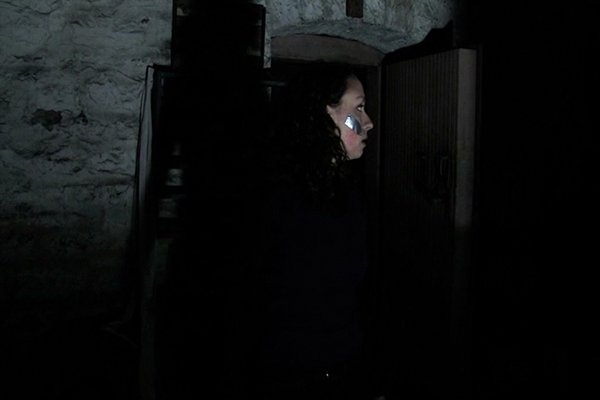
Duct tape is just a good as a band-aid.
The Story: Pax is called back to Toronto to retrieve the body of his former partner, and gets to meet up with his UCF mentor, a history professor. The professor is reported as kidnapped when he misses an appointment. Pax and company are called in to investigate when a member of the Luddites is considered the prime suspect. The investigation leads the UCF team to a prison for cyborgs where the Luddites plan to use the inmates in their ultimate plan; To use retrieve the nanotechnology in Pax’s deceased partner.
The game. A recurring theme is the chess game; Specifically, how the action is equivalent to moves and counter-moves on a chess board.
If that’s true then Equilibrium’s gun-fu scenes should be considered hands of Texas Hold-Em.
Seriously, every action movie would like to be compared to chess; That all the gun-play and violence has some intellectual reason and not just eye candy. For Abstract Messiah, they take the comparison to a new level starting with a real chess match between Pax and his Foundation mentor.

“While you were watching us learn, we were watching you teach.”
Such back and forth banter isn’t uncommon in action movies, as each side tries to impart their vision to the other. But when the two are bitter rivals, diametrical opposites of each other, that’s when the chess game quickly becomes an NBA-style trash talk fest, right before everyone STFU and lets their guns speak for them. Fortunately, Abstract Messiah doesn’t get to the trash-talk even though Crom does come off as the right-wingnut zealot type (nicely played). In fact, I keep getting this feeling that this movie is just one minor move in a much larger game.
Knuckle dusted. If there was a major problem with Abstract Messiah, it was the fight scenes. The fisticuffs weren’t all that convincing, but when a limited budget limits the use of professional stunt people you just have to use what you got and keep them safe for a possible part three.

“The Luddites refuse to be slaves to the cybernetic machines, and I refuse to continue being a slave to the machinations of the Foundation.”
Conclusion: Since the original UCF short was released back in ‘06 there was a call for more of the Luddites. This should satisfy them for a good 80 minutes as the Luddites are now front and center.
Everyone should consider getting Abstract Messiah even if just to support indie movie makers like Key Pixel. Even with amateurish production on a shoe-string budget they still manage to make a movie that’s more watchable than what some major distributors with trillion-dollar purses have been cranking out lately.
One has to wonder what UCF 3 would be like, especially if they get a larger budget. Dare to dream… until Kovacs sends a PM saying he has a screener ready to preview.
Movie Review By: SFAM
Year: 2004
Directed by: Hiroki Yamaguchi
Written by: Hiroki Yamaguchi
IMDB Reference
Degree of Cyberpunk Visuals: High
Correlation to Cyberpunk Themes: High
Key Cast Members:
- Luchino: Luchino Fujisaki
- Elevator Operator: Ninalada Mochiduki
- Business Man: Viblio Sawatsukumori
- Housewife: Alamocia Nakaji
- Headphone Guy: Nocosh Utsunomiya
- Serial Rapist (prisoner): Zitacock Obitani
- Bomber (prisonor): Calpico Teranouchi
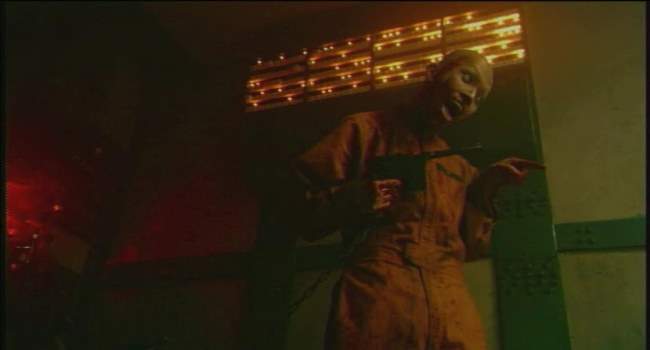
Overview: One thing I love about Indie movies is the opportunity for complete originality. Indie director Hiroki Yamaguchi delivers a strange, but very well made micro-budget movie that is truly unique. From viewing the extras, virtually every part of the set was designed by searching through junkyards for throw-offs. Similar to the Cube, Hellevator: The Bottled Fools largely takes place on a single set. Similar to Brazil, the world of Hellevator is a bizarrely dystopic surveillance society where things just don’t seem to work right. Nobody got paid who worked on this, but you wouldn’t know it from the quality. Hellevator definitely has its own feel.

The Setting: Hellevator takes place in a non-specific dystopic near future, where a colony of people have long ago decided to move underground. While some aspects of life clearly involve advanced technologies, there is a strong analog, mechanistic component to society. Now, all life takes place in a very large megalopolis comprised of a set of very large levels and tunnels. Life is fully governed by an omnipresent security force, who have cameras in all key locations. Over 130 levels in all, each has a specific purpose. Some have hospitals or schools, others are power centers, and Level 99 is the prison ward. Because everything is underground, issues related to air quality are at a premium. Smoking is illegal, and merits a death sentence. To get from each level, people use these very large, mechanical elevators.

The Story: The beginning of Hellevator starts off with a television report of a set of explosions on Level 138, which ends up killing over 100 people. The police have pegged a few suspects of causing this crime, both of which ended up stuck on an elevator which malfunctioned during the explosion. Flashback to Luchino (played by Luchino Fujisaki) who is a troubled teen-age girl living on Level 138 who is on her way to school, which is on Level 4. She has a penchant for rebelling against the system and starts her day by illegally purchasing cigarettes from a drug dealer. Unfortunately, she almost gets caught, and ends up leaving her still burning cigarette butt at the power center near a set of flammable fluid containers.
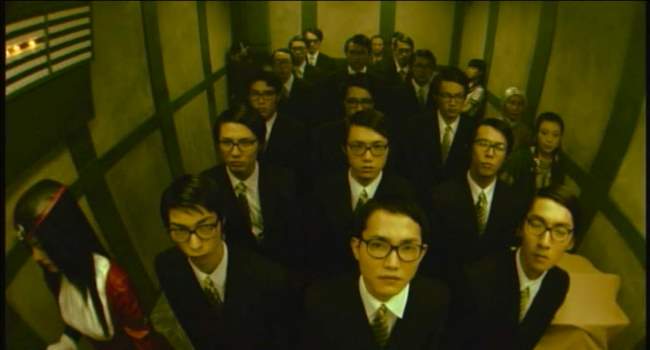
Luchino gets on the elevator to take her to level 4, which is where the rest of the story takes place. On each floor, new people get on while others leave. Eventually when the elevator gets past 110, the elevator operator announces that they have entered the “express mode” – no more stops should occur for a long time. At this point, the elevator is holding the white-gloved elevator operator (Ninalada Mochiduki), a business man (Viblio Sawatsukumori), a woman with a baby carriage (Alamocia Nakaji), a quite guy with headphones (Nocosh Utsunomiya) and Luchino. Unfortunately, the elevator is force-stopped at level 99, the prison level. Two prisoners, one a bomber (Calpico Teranouchi), and the other a serial rapist (played wonderfully by Zitacock Obitani) get on with a very unstable young prison guard. Shortly afterwards, the explosion on Level 138 occurs. This causes the elevator to malfunction, and the small group is now stranded.
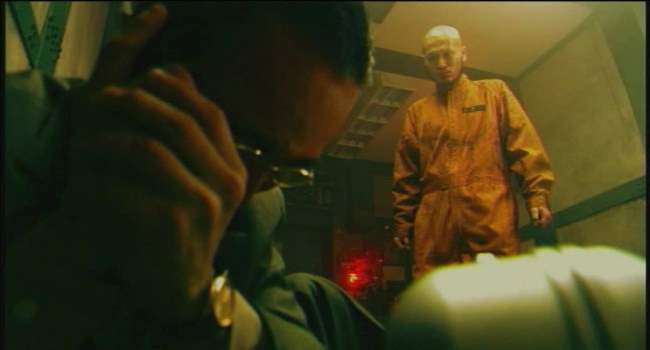
The malfunctioned elevator becomes a powder keg for runaway paranoia. The prison guard starts to lose it, and through a strange sequence of events, causes the prisoners to become free. The rapist quickly beats the guard to a pulp, which ends with a sequence where he takes a bite out of the guard’s neck. From there the prisoners sadistically start to impose their will on the beleaguered elevator participants. The rapist starts to do his thing on the elevator operator and eventually starts kicking Luchino. Luchino starts to have flashbacks of times when her father abused her similarly - Luchino eventually snaps. She picks up the gun and starts to repeatedly shoot the bomber prisoner.

From there, the story devolves into a repetitive set of sequential events which cause various people on the elevator to lose control. Some result in murders while others result in interesting character expositions. Throughout, the mood is high tension paranoia. Eventually, the THX-1138-like guards break the remaining few left alive. The story then connects back to the police detective, who is in the process of interviewing those that survived the elevator trip. The ending, not discussed here, provides a different take on the world which this future takes place.
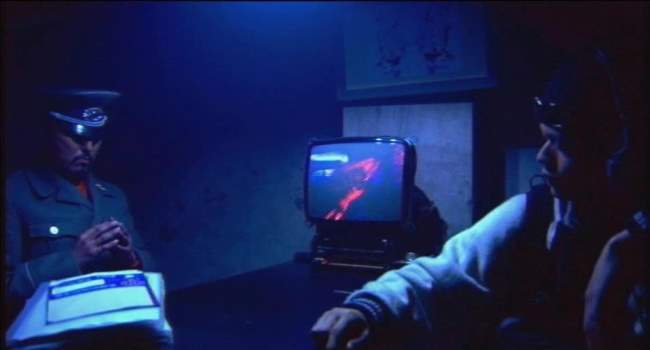
The Acting: The acting in Hellevator is far better than one would expect in a movie where nobody was getting paid. Luchino Fujisaki turns in a solid performance as a person devolving back into psychosis. Zitacock Obitani is terrific as an extremely bizarre serial rapist, and almost makes the movie a must-watch all by himself. The rest of the cast works. The only stand-out lousy performance is turned in by the blond haired prisoner guard, but he doesn’t last long enough to matter.
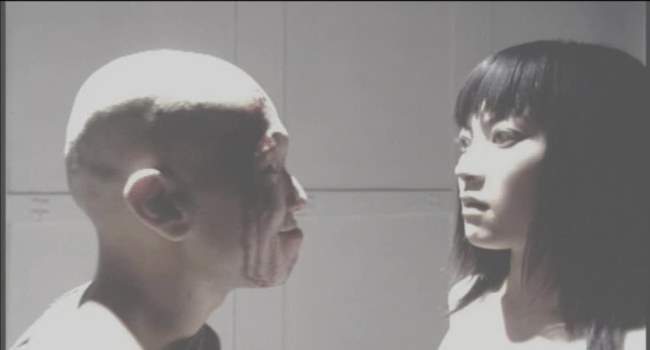
The Cinematography: Hellevator, uses two omnipresent color schemes: within the elevator, everything is dingy yellows and greens. For the police interrogation scenes, everything is dark blue. Yamaguchi makes liberal use of perspective shots, sometimes involving fish-eye lenses, and frequently looking down or up at the participants. In short, Yamaguchi makes the most of a very limited budget and set. He even throws in a Matrix slo-mo shot that was apparently filmed with a single camera.
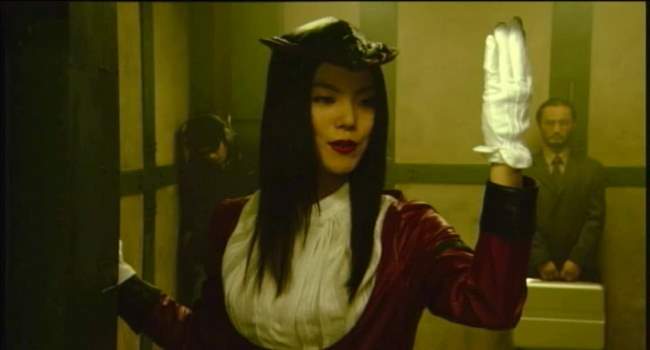
System Service Staff as Robots: In Hellevator, the elevator lady acts completely robotic until the convicts break things. Her overt disposition is of a person who never gets rattled, never intimates a personal connection, and never changes her demeanor regardless of the surroundings. In a sense, she is the perfect employee for the underground megalopolis. Similar to movies like Brazil or 1984, the elevator lady represents the humans as machines metaphor. In this view, we are nothing more than a single redundant part – a cog in a massive machine. For the ideal system employee, individualism has been quashed in favor of ritualized, repeatable routines.
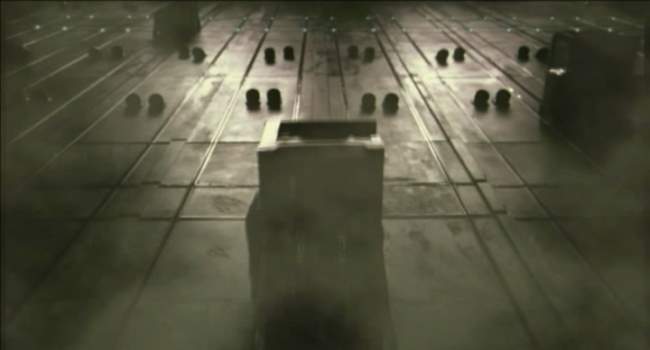
Telepathy: Hellevator does a good job of integrating telepaths into its strange world. The majority of the people are normal, and do not recognize the telepaths. In Hellevator, the Telepaths are able to notice when another uses their sensory perception. What makes Yamaguchi’s view of telepath’s somewhat interesting is he also touches on their ability to see others’ memories. This leads to some interesting flashbacks of others’ experiences on the elevator. More interesting though is the fact that Luchino’s personal psychosis colors her views of the others’ memories. This turns reading thoughts into something far less precise, and in the end makes it more believable.
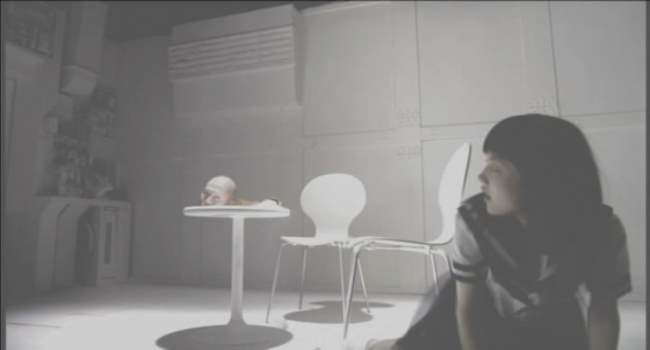
Repression Exposed by Extreme Psychological Pressure: Hellevator explores extreme psychological pressures on a group of already unstable people. Everyone stuck on the elevator is hiding something significant about themselves. The businessman is potentially a bioterrorist; the woman with the crib is hiding groceries instead of a baby, and the quiet guy in the corner is masquerading as a cop. Luchino had been abused by her father to the point that she eventually flipped and killed him. She has since repressed her issues but when placed in a similar circumstance, Luchino responds similarly and goes on to murder one of the convicts. Her perception of reality starts to bear little resemblance to the rest. The robotic elevator woman turns into an emotional basket case. Although this is a fully reasonable reaction to an attempted rape, the contrast shown is with her earlier robotic persona. In fact, everyone, when thrown into this circumstance acts in wholly strange ways.
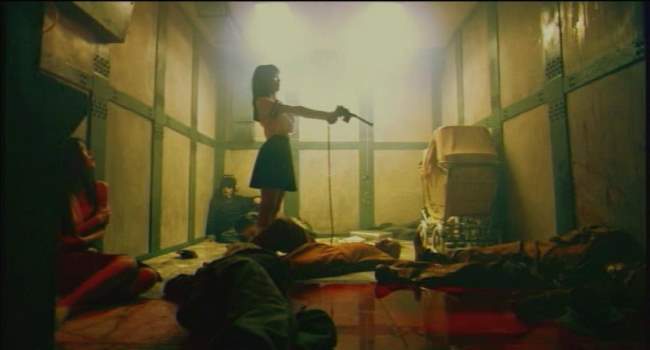
The Bottom Line: If you like Extreme Japanese Cyberpunk movies, Hellevator: The Bottled Fools is well worth a watch. There’s quite a bit of blood and gore, but not when compared to some of the more extreme straight Japanese horrors. The plot is pretty straightforward once the movie gets moving – I would have wished for a bit more interplay between the plot points. Also, there are a number of plot points which were touched on as significant, but were never completed. But overall, the movie is original and interesting. Little throwaways like the child’s pet brain only add to the fun. Yamaguchi and crew really make the most of their set and the overall shoot. This one will stay with you for a few days.
Page 2: More Screencaps –>>
Movie Review By: SFAM
Year: 2006
Directed by: Warren Amerman
Written by: Warren Amerman & Marty Langford
IMDB Reference
Degree of Cyberpunk Visuals: Low
Correlation to Cyberpunk Themes: Medium
Key Cast Members:
- Magdalena: Amy Shelton-White
- Jim: Robert Weingartner
- Arthur: Sanjiban Sellew
- Andrew: David Joseph
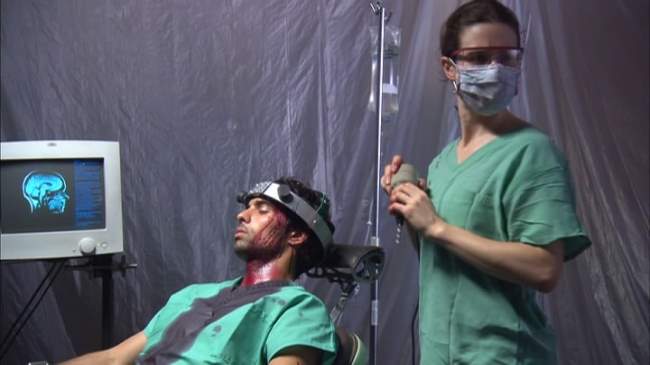
Overview: Rarely do we find low-budget horror movies aspiring to be as intelligent and ambitious as Magdalena’s Brain. Reportedly shot on a shoestring budget of $25 - $30K, Magdalena’s Brain is a professional looking film with some interesting man-machine interface ideas. To limit costs, most of the movie takes place in a single warehouse setting. Unfortunately, this psychological horror is probably a bit too slow for most, and doesn’t have enough gore for the average horror fan (although there are a few good freak-out scenes). But if you do stick with it, you get treated to a fascinating ending twist.
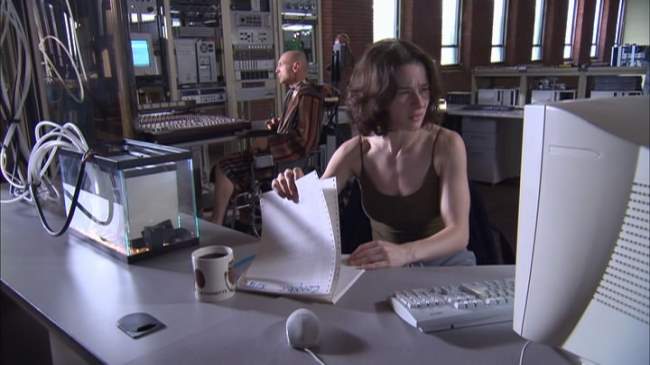
The Story: Former brain surgeon, Magdalena (played wonderfully by Amy Shelton-White) is now a reclusive alcoholic, living in a warehouse, who continually changes out shrinks in the hopes of gaining some semblance of peace. Four years after a tragic accident that left her brilliant husband-scientist, Arthur (Sanjiban Sellew) a quadriplegic and their research in tatters, Magdalena has persevered in the fleeting hopes that things will improve. Magdalena has designed an implant that allows computer-assisted dialogue with her husband. With communication restored, they have been able to continue their research in developing a synthetic brain that processes information 1000 time faster than humans. While the last four years have been slow going, recent advances have shown promise. Currently a blank slate, the organic, crystalline brain structure appears ready memories implanting. Andrew (David Joseph), a love struck former patient of Magdalena (he has inoperable brain cancer), seems to be an obvious test subject, as he will do anything to win over Magdalena.

Magdalena reluctantly takes Arthur’s advice and accepts the help of her creepy brother, Jim (Robert Weingartner), in working out how to kick-start the organic crystalline brain. First, they will download Arthur’s memories into the crystalline structure, then insert the structure into Andrew’s brain, and finally they will remove the tumor. As the story continues, Magdalena becomes more unstable. As everything comes to a head, it appears as if the same issues that led to the tragic accident four years ago might be recurring.

The Pacing: The pacing in Magdalena’s Brain is problematic in places. The first half of the movie crawls at a snail’s pace. In part it’s due to the plot, but the editing decisions certainly contribute. Eventually, it picks up in the second half. The middle of the second half is really where Magdalena’s Brain hits its stride, both in plot and pacing. The movement is brisk and the scenes really tie together well. Unfortunately, the ending action sequence comes across a series of jumbled scenes (again, I’m blaming the editing here). Instead of the frantic chase, they would have been better served having their victim do the slow, bloody crawl, with Magdalena walking after while engaged in her personal struggle. The story would have worked the same either way, but the chosen course asks us to believe that a brain surgeon can’t determine if someone is dead, and that a guy who just had a hole drilled in his brain can run for his life.
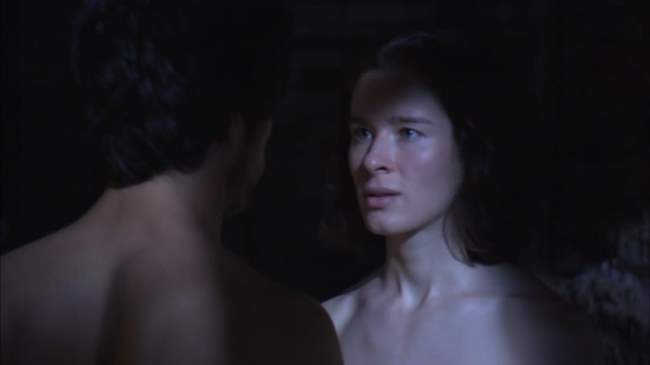
The Acting: If there’s one decision that Director Warren Amerman made that other extremely low budget film projects should consider emulating was hiring a real actor/actress to play the lead role. Even with having only a $25,000 budget, a large chunk of that went toward hiring Lost-Angeles based actress, Amy Shelton-White. Had they not done this, Magdalena’s Brain might have been a disaster. Shelton-White shines to the point that she single-handedly carries the project toward respectability, while adeptly displaying a wide range of talent and emotion. The script is problematic in places, the pacing is too slow, and the rest of the cast are role players at best, but in the end this film still works due to Shelton-White’s performance. Being in virtually every scene, she seems to bring out the best in the rest of the cast. I say this because the rest of the cast suffers when in monologue type situations, but generally hold up well when interacting with Amy. David Joseph (Andrew) in particular looks really shaky in places where he’s basically on his own, but gets lots better when interacting with Shelton-White. I haven’t seen Shelton-White in anything else, but clearly she has the chops to go places. Other the lead, the only performance with mentioning is Robert Weingartner – the “look” he generates as a creepy side-kick really worked well.
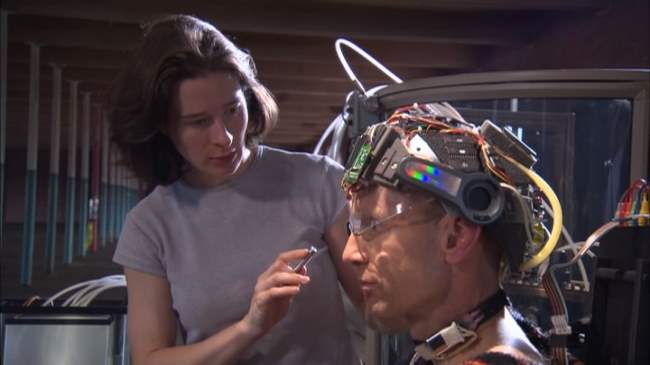
The Cinematography: Often indie films that venture into the Science Fiction genre attempt to make up for low-budget effects with innovative cinematography and lighting. This definitely is the case for Magdalena’s Brain. The use of lighting and shadow always seems to be in the forefront of Amerman’s thinking when composing a shot. Some scenes, such as the bowling scene, really don’t seem to have a place in the film from a story standpoint, but are probably left there due to the wonderful lighting and composition. Throughout the film Amerman is able to take a truly dingy set and come up with some wonderful shots. Also interesting is the lighting and sound choices for the flashbacks, although the horror shots have a cheesy low-budget feel to them. This, along with Shelton-White’s performance is able to help get the viewer through some of the pacing and editing issues.

Problems With Organic Brain Design: Magdalena’s Brain uses a different approach toward creating AI. Instead of building a set of programs that mimic some trait of humanity (referred to as the “brute force method), they attempt to replicate the operations of a brain. Through the creation of a “crystalline lattice work in a gel suspension” – the thought is to create a structure that supports the firing of electrodes in a way that allows it to build its own pathways and connections. This part of the techy “mumbo jumbo” was wonderfully thought out, sparking interesting thoughts on how one might go about connecting such a “blank slate” learning structure artificial senses so that it might interact with the outside environment. One can imagine that a structure such as this, once connected to sensory input could grow at an impressive rate

Unfortunately, this is where their science falls apart. They “solve” the blank slate problem by simply “downloading” Arthur’s memories into the crystalline brain. Worse, the brain will apparently make its own pathways using a “first-come, first-served” method of storage. Not only does this approach smack of a “miracle occurs here” scaffold, it also removes most of the innovativeness of the crystalline brain learning structure – as opposed to the pathways being organically grown based on ongoing input from its environment, they simply load a bundle of memories (which are apparently discrete chunks of data) up in sequential fashion. In doing so, they seem to be valuing the mass-storage view of the brain while discounting the interconnectedness of the pathways and concepts. This wouldn’t be too much of a problem accept that their synthetic brain seems based on creating its own connections based on organic growth.

Integration of Synthetic Processing Structures with Human Brains: The most interesting cyberpunk thought in Magdalena’s Brain involves integrating synthetic processing structures with human brains. In the movie, the integrated structure will already have a sentient presence in it (see the downloading memories part above). This is an interesting approach toward building a cyborg with synthetic thinking capabilities, and is a somewhat different approach from say, the Ghost in the Shell method of increasing human capacity. In the GITS Cyborg model, computers are essentially integrated into the human mind, almost as a huge memory bank. The action thinking and decision making largely remain with the human portion of the brain (there are also fully AI processors like the Puppet Master, but they aren’t cyborgs). In the Magdalena’s Brain approach toward cyborgs, one wonders what happens when the two brain structures (synthetic and natural) occupy the same body – will they work in harmony; will one dominate the other; or will a type of schizophrenia emerge? This is all the more interesting when transposed against the psychological struggle Magdalena is undergoing.

Is Magdalena’s Brain Cyberpunk? Magdalena’s Brain is one of those movies that I think barely makes it into the genre. It takes place in the present, not near future (at least that we can tell), and has no connections to evil corporations. Nor does it have much in the way of cyberpunk visuals. It does however have negative impact of technology down in spades, and an interesting take on the fusion of man and machine. For these reasons, I’ve decided to include it, but just barely.

The Bottom Line: Magdalena’s Brain puts forward a terrific production considering the virtually non-existent budget. It’s very difficult to do a convincing science fiction movie on that type of shoot. I would like discuss the psychological horror aspect of Magdalena’s Brain, but won’t for fear of ruining the ending. The high points are definitely Amy Shelton-White’s performance, and a good number of some well-shot scenes. The audio FX are also worth mentioning, but the score doesn’t always fit. That said, the pacing issues will significantly reduce the potential market for Magdalena’s Brain, as most horror (and many cyberpunk) fans won’t stick with it long enough to get to the fast-paced ending. While it certainly has its problems, Magdalena’s Brain gets a passing grade. There is enough here for indie fans to give it a go, and enough of a jolt at the end that many horror fans will enjoy as well.
Movie Review By: SFAM
Year: 2002
Directed by: Kurt Wimmer
Written by: Kurt Wimmer
IMDB Reference
Degree of Cyberpunk Visuals: High
Correlation to Cyberpunk Themes: Medium
Key Cast Members:
Cleric John Preston: Christian Bale
Dupont: Angus Macfadyen
Errol Partridge: Sean Bean
Brandt: Taye Diggs
Jürgen: William Fichtner
Mary O’Brien: Emily Watson
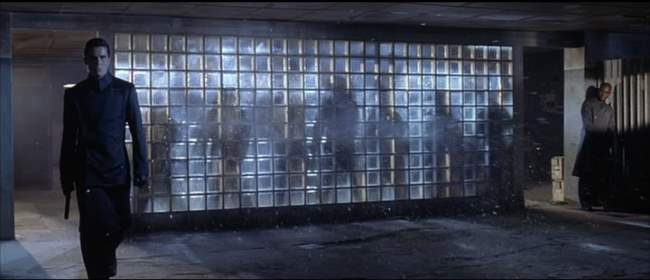
Overview: Equilibrium is one of those movies that most everyone who knows of it has only seen it on DVD. Essentially thrown away by its studio, Equilibrium, created for a budget just over 20 million was given no dollars for marketing and made less than a million at the box office. But don’t let that sway you into thinking this movie is a piece of trash. Equilibrium has become a cult DVD hit. Made in Eastern Germany portion of Berlin, Equilibrium looks lots more substantial than the 20 million that went into it. Due to some terrific location choices, Equilibrium shines with a polish of a movie made for at least twice that budget. This, plus high quality acting and at least a modicum of interesting thought raise Equilibrium up from the pop-FX action-fest that it otherwise might have become.
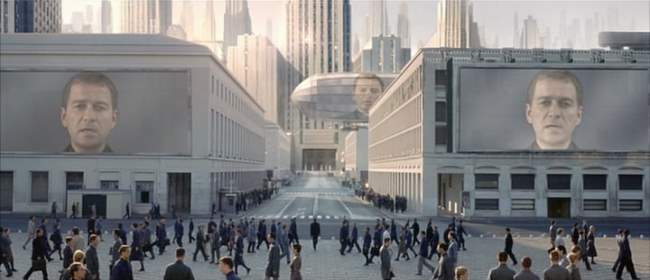
The Setting: Set sometime in the 21st century, after a massive nuclear war has wiped out the majority of the human race, a 1984 style society has emerged after a method of full population control was discovered. The entire population is now given a daily dose of a drug called of Prozium. Prozium removes all semblances of emotion, and leaves the populace docile and controlled. Exhibiting emotion is now considered the greatest of all crimes, and is punishable by death. The all-knowing, all-controlling “Father” has constructed a group of supra-police called “clerics” who spend their time seeking out “sense offenders” and burning all remnants of the old way.
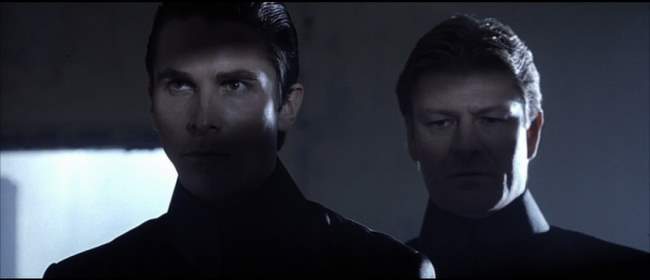
The Story: Cleric John Preston (starring Christian Bale) is among the best cleric enforcers. Along with his partner, Errol Partridge (Sean Bean), they spend their days burning heretical artifacts like the Mona Lisa and bringing sense offenders in for processing – a euphemism for baking people in a large oven. Unfortunately, Partridge has begun to have doubts about society, and has apparently stopped taking the drug. After Preston finds out and kills him, Partridge’s final thoughts compel Preston to revisit his own personal history in which he showed no emotions as his wife was burned for sense making. Preston begins to question the intense surveillance society.
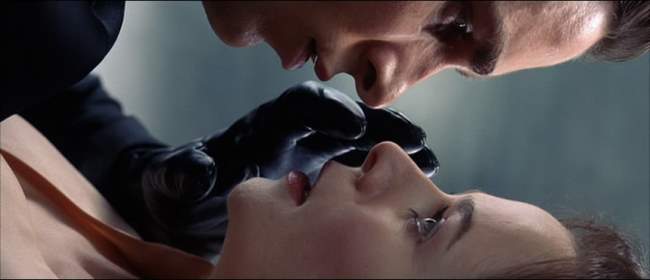
In tracking down Partridge’s lover (Emily Watson), Preston’s world finally crumbles. Now he realizes he has presided over the destruction of humanity, and can no longer continue. Unfortunately, Dupont (Angus Macfadyen), the mouthpiece of the Father and leader of the Clerics has asked Preston to infiltrate the remainder of the resistance in order to crush them once and for all. But Preston is actually approached by the resistance leader, Jürgen (William Fichtner) who has noticed his recent spate of emotion. While Preston is still conflicted, Jürgen tries to enlist Preston in destroying the Father. Even worse, Preston’s ambitious new partner, Brandt (Taye Diggs) strongly suspects Preston of becoming a sense offender.
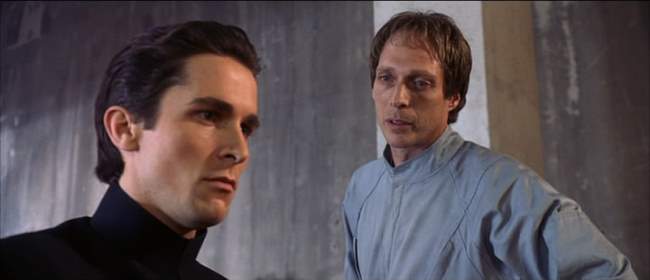
The Acting: The acting in Equilibrium is top notch. For my money, the best performance is turned in by Sean Bean, who, while only on screen for a brief time, really hammers home the essence of the message Equilibrium is conveying. But truly, all the main cast is terrific. Bale does a very good job in going through a conversion in losing his faith, while Fichtner, Macfadyen, Diggs and Watson all really add real believability to a somewhat forced story. Truly, the acting sets Equilibrium above a better than average genre movie to something really worth watching.
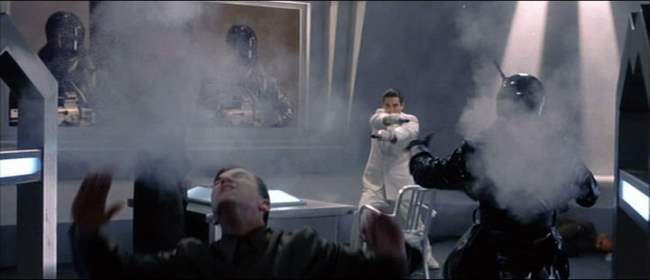
The Action - GunKata: Gunkata is Kurt Wimmer’s newly invented martial art – gun combat in close quarters. The idea is that body positioning and fluid movements, along with an intense understanding of one’s opponents’ most likely actions will allow the Gunkata master – Clerics, in Equilibrium – to be close to unstoppable. Many times in Equilibrium, Preston goes into a room LOADED of bad guys and wipes them all out. Does it look in the least realistic? Not at all, but it does look cool. The action sequences are hectic by design, but are always well planned out and executed. Even if you could care less about the message, if you like gun fighting, Equilibrium is for you!
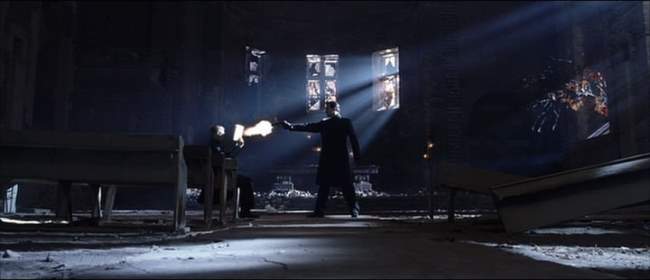
The Visuals: The color of the day for Equilibrium is black, gray and occasionally white. Virtually everything is in black with brief highlights. This makes the instances where other colors are used, such as Preston’s Bruce Lee white outfit near the end of the picture, or the yellow sunset as seeming enormously more significant than they normally would seem. The other dominant theme is squared off architecture. Everything here is comprised of right angles to emphasize the controlled, boxed-in feel of the society. Even worse, the only prominent place that a circle appears is the processing factory, where sense-offenders are burned. Wimmer uses his most excellent set selections to optimal effect. The Cinematography choices always go for high shadows and contrasts, and usually come from interesting angles and contexts. Without trying to resort to high-tech wizardry, the world Wimmer ultimately creates is believable and otherworldly.
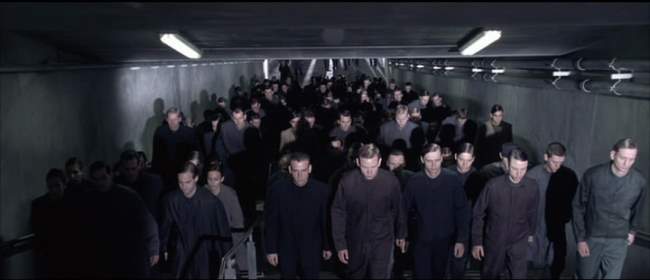
Centralized Control and the Surveillance Society: While the message is often obscured by the slick visuals and action sequences, Equilibrium’s basis is right out of the Metropolis, 1984 model. In looking at a situation where humanity has gone awry, the corrective procedure is one which divorces people from that which makes them human – their emotions. In this model, emotion control leads to thought control, which yields a smooth, functioning society. The warning is clear – if we move down a road that involves giving up our personal freedom, the danger is that we lose our technology. If I were to point out quibbles with this, the idea of the single, evil genius behind all of everything bad lessons the impact. The message conveyed is that society slowly made the choice to go this route – it would have been better to see remnants of that choice still guiding the society versus the simple “glorious leader” bad guy.
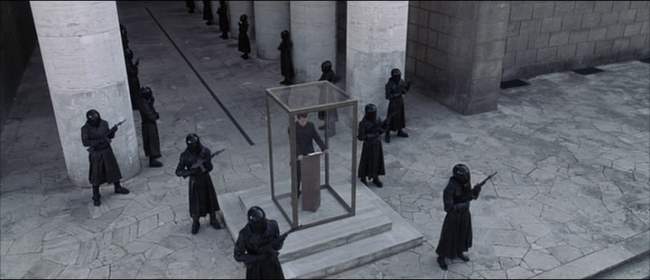
Is There Any Relevance to Today’s World? While only briefly mentioned by Sean Bean’s character, Partridge discusses the “trade off” that humanity made. In exchange for security and stability, they agreed to trade away their freewill. One gets the sense that this was a slow process at first, but which picked up dramatically once centralized control was present. While it’s a far stretch to imagine an emotion blocker being instituted, if we imagine freewill as a sliding scale, its clear that the debate between our personal freedoms and societal security measures are clashing right now. One can only imagine how much greater support the security side would be if in fact a nuclear conflict did break out. Unfortunately, this too is becoming far more likely – in 20 years, we can certainly envision that the number of groups and governments in possession of nuclear material will be far greater than today. The risk isn’t just that a small group of terrorists will use it. Unfortunately, pre-emption of conflict by larger countries could also lead to such a response. In short, as the concern for security and stability are greater, the pressure to impact personal freedoms will grow. If this isn’t a key ingredient for the creation of a cyberpunked world, I don’t know what would be.
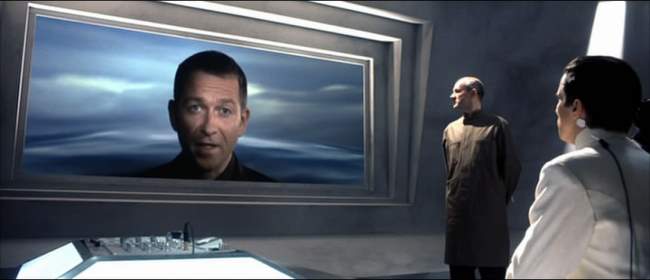
Is Equilibrium Cyberpunk? This is an open question at some level, but I’ve come down on the “yes” side (obviously, as its reviewed here) for three reasons. First, in Equilibrium, centralized control dominates all “above ground” communication, while the horizontal control is the domain of the rebels. We don’t really see any instances of an internet, but we know it exists in some form, based on the rebel leader Jürgen’s comments. The only true downer from a cyberpunk control standpoint is the book used to record contraband – gimme a break, Wimmer! The second reason is the drug, Prozium. The bio-engineered drugs serve as a dominating form of technology that serves to dehumanize society. Until we separate out “Biopunk” movies from Cyberpunk, Equilibrium belongs here. Thirdly, the visuals TRULY fit into a post-Matrix cyberpunk visual style. Without hearing a lick of dialogue, if you only saw the visuals, you might consider sticking Equilibrium into the cyberpunk bucket.
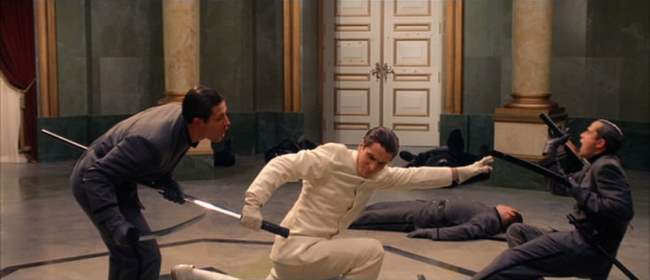
The Bottom Line: Equilibrium makes the most of its 20 million dollar budget. Truly, after watching it, most people are shocked to find out how little was spent on making Equilibrium. From an execution standpoint, everything fits like a sleeck black glove. From the well integrated and motivating score, to the high quality acting, to the even pacing, Equilibrium works to create a very believable mood. On top of this, Equilibrium’s action is hot shit! Wimmer’s creation of GunKata - a new martial arts for close-combat gunfighting is interesting and innovative. However, the story itself is still a stretch, as is the believability of the Gunkata. In the end though, this is really a minor quibble, as the end product is intelligent enough to cause you to ponder while engaging enough to keep you entertained.
~See movies similar to this one~
Movie Review By: SFAM
Year: 2001
Directed by: Sogo Ishii
Written by: Sogo Ishii
IMDB Reference
Degree of Cyberpunk Visuals: High
Correlation to Cyberpunk Themes: Medium
Key Cast Members:
Dragon Eye Morrison: Tadanobu Asano
Thunderbolt Buddha: Masatoshi Nagase
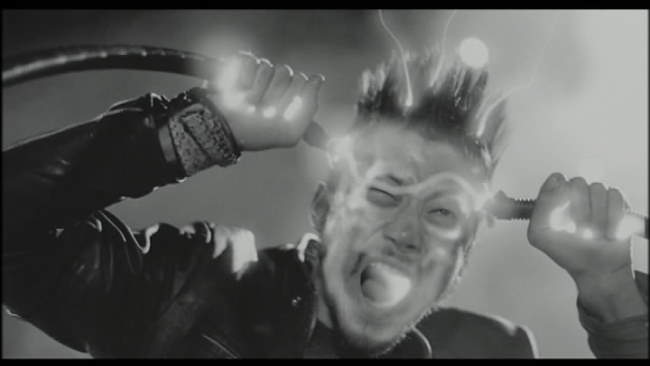
Overview: Sogo Ishii, master of the Japanese Extreme Cinema delivers a truly bizarre experience for us in Electric Dragon 80,000V. If you added the dialogue from this whole movie up, you probably wouldn’t get much more than a page or two. The story is told through visuals, and that said, the narrative itself isn’t all that deep. So why do I give the movie a decent rating? Simple – the visuals and the overall mood this film creates are absolutely unique. Electric Dragon 80,000V is first and foremost an experiential flick. The narrative definitely takes a back seat to the visual and sound integration.
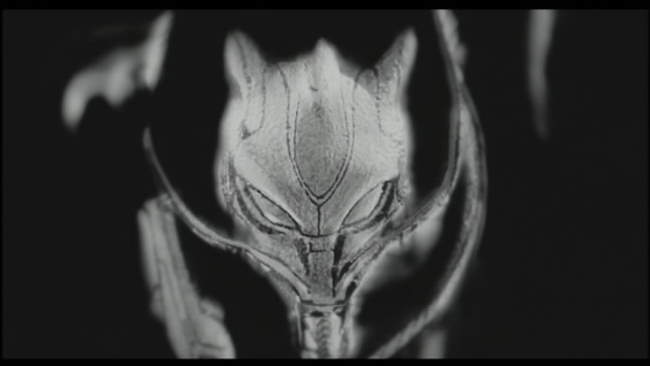
The Story: Electric Dragon 80,0000V follows the maturation of two kids who had traumatic experiences with electricity when they were young. One, Dragon Eye Morrison (played by Tadanobu Asano, who also stars as Kakihara in Ichii, the Killer), underwent electric shock treatment due to being violent as a kid – specifically, he endured 80,000 Volts of electricity. When Dragon Eye Morrison undergoes electric shock treatment, something in his reaction awakens the Dragon. The Dragon is the Eastern style dragon – one that’s embedded in all living things and the world at large. Dragon Eye Morrison’s connection with the dragon releases the rage within in, and thus, forces him to get more shock treatments. With each electric shock treatment, he develops a deeper connection with the dragon. By the time he’s an adult, Morrison can commune with reptiles (he owns a bunch), and has learned that playing REALLY LOUD guitar music (well, playing really loud anyways) is able to sooth the rage within him.
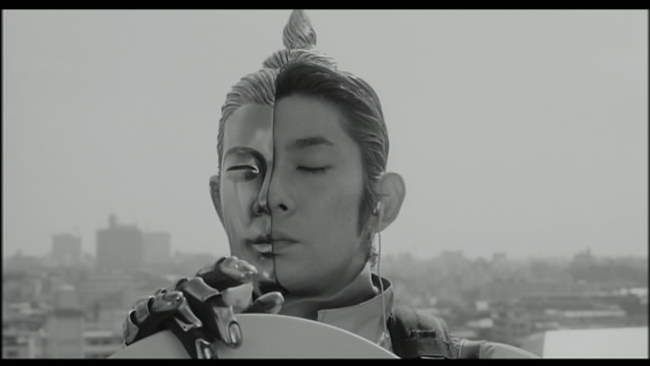
The other, Thunderbolt Buddha (Masatoshi Nagase) got electrocuted with 20 million volts while attempting to climb a power-line tower. The electricity is so high that half of his body becomes encased in metal – and in fact his personality is as split as his body. One side of him is trying to kill himself, while the other is deviously listening in on all electric conversations within his vicinity. It’s not to hard to figure out that Thunderbolt Budda is the bad guy in this modern Godzilla story.
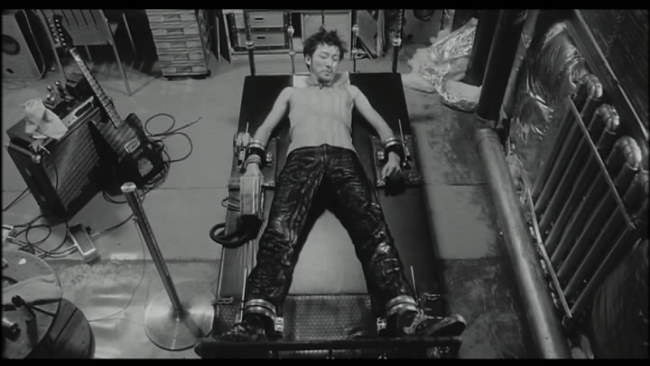
By the time they are both adults, somehow Thunderbolt Buddha, who spends his time attached to a satellite dish, scanning the city, finds out about Dragon Eye Morrison – worse, he decides that the world isn’t big enough for the both of them! So Thunderbolt invades Morrison’s apartment and kills some of his lizards and takes others prisoner. Sure enough, Dragon Eye Morrison figures out who the culprit is and they meet at high noon! From there – it. is. ON BABY!!!!
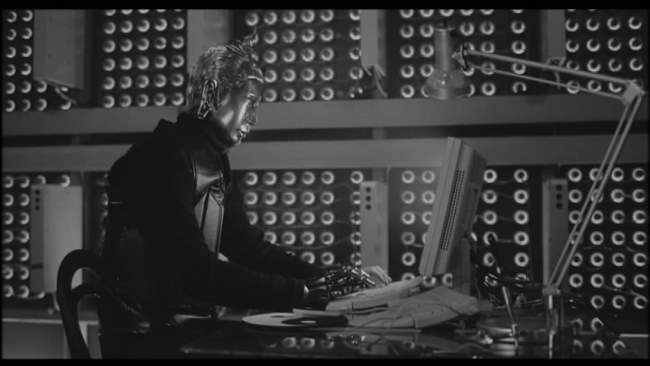
What the Fuck is This Movie About? Yes, at first glance, this movie appears to be pretty shallow and non-sensical, and it may just be. But I like deeper meanings, so allow me to intuit. OK – assuming there is any meaning one can derive from this movie, my wild ass guess is it is this – Dragon Eye Morrison represents the Dragon on earth personified, whereas Thunderbolt Buddha represents modern technology. At first glance, modern technology appears stronger than the earth (20,000 volts to 80,000), yet, due to his ability to bring the full might of the dragon to bare, he’s able to stand up to modern technology. What’s interesting about this theory is the reversal of fortunes: Dragon Eye Morrison gets transformed to merging with the Dragon (earth) due to the detrimental use of technology on him, whereas Thunderbolt Buddha is transformed by a natural occurrence – lighting. In a sense, both grow up reacting against that which transformed them. Or, um, my theory is full of bunk – you make the call. 
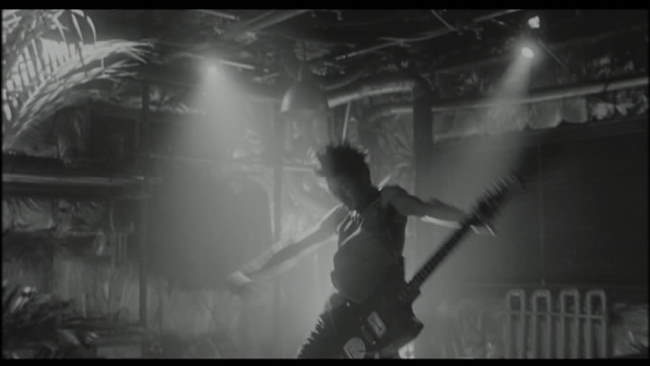
The Sound: As tightly integrated as can be, Electric Dragon 80,000V links massively loud and distorted guitar sounds with the kinetic visuals. This is really the true genius of Ishii’s work. Like all Japanese Cyberpunk movies, Electric Dragon provides an assault on the senses. Unlike most, the assault in this case isn’t as strong on notion of humanity itself, but is instead an assault on you, the viewer. To really experience this movie in the way it was intended, I STRONGLY recommend absolutely cranking the sound. If you don’t do this, you really will lose out on the mood this picture tries to set, and really, will not get the attraction
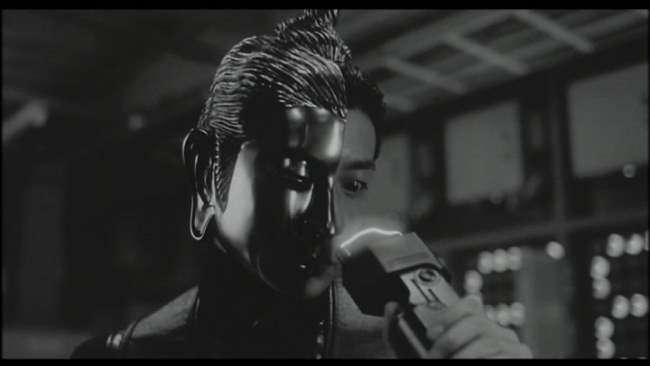
The Visuals: Electric Dragon 80,000V is really rather sedate for the first half. While well shot, the visuals aren’t really that noteworthy from a Japanese Cyberpunk standpoint. But the second half is FILLED with a bevy of truly bizarre shots. Electricity integrated with humans is the theme, and it is explored in a variety of ways, though showing various forms of electricity to kinetic shots of volts coursing through our lead characters. The second half uses the same style of stop-motion animation we get in Tetsuo - The Iron Man. While the movies are radically different, the movement of these two films is pretty similar.
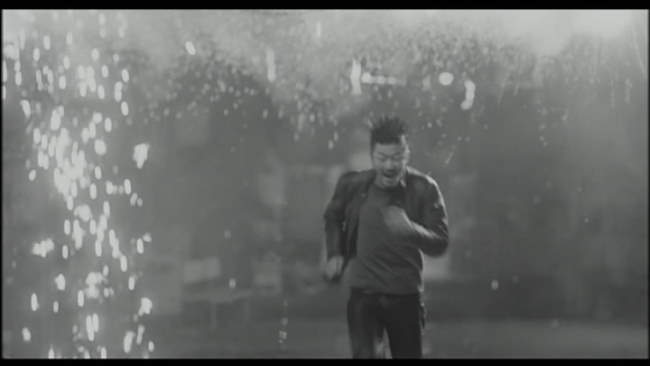
The Bottom Line: Electric Dragon 80,000V is clearly an indulgence in extremes. The mood brought on by the sounds and visuals far outweighs what little exists of the narrative. In the end, Electric Dragon 80,000V is either a movie you really dig or absolutely abhor. For this reason, I find it pretty difficult to give a solid rating, so I’ve gone with 7 stars - which implies that it’s a good movie, but one that some may not like. The entire thing is barely 50 minutes, so if you find yourself hating it, not to worry, it will be over soon. If you do like it though, Electric Dragon 80,000V has solid replay value.
~See movies similar to this one~
Movie Review By: SFAM
Year: 2005
Directed by: James Bai
Written by: James Bai
IMDB Reference
Degree of Cyberpunk Visuals: Low
Correlation to Cyberpunk Themes: High
Key Cast Members:
- Puzzlehead/Walter: Stephen Galaida
- Julia: Robbie Shapiro

Overview: First let me give a great big THANK YOU to Puzzlehead Director, James Bai, who gave me a copy of this movie to review, even though it has not yet been released for general distribution (Indie filmmakers - take note! Feel free to send me your cyberpunk films to review prior to release!  ). In looking at the movie poster and in hearing from others, I just HAD to get a copy of this to watch. Puzzlehead is about as far as you can get from a Hollywood production. You won’t see fast-paced action sequences here (quite the contrary – the movie is very slow paced), nor will you get futuristic scenery, or high-end FX. But make no mistake – even though the cyberpunk visuals are sparse, this is DEFINITELY a cyberpunk movie. The themes introduced and the fractured sense of humanity are fully cyberpunk. ). In looking at the movie poster and in hearing from others, I just HAD to get a copy of this to watch. Puzzlehead is about as far as you can get from a Hollywood production. You won’t see fast-paced action sequences here (quite the contrary – the movie is very slow paced), nor will you get futuristic scenery, or high-end FX. But make no mistake – even though the cyberpunk visuals are sparse, this is DEFINITELY a cyberpunk movie. The themes introduced and the fractured sense of humanity are fully cyberpunk.

The Setting: Puzzlehead takes place in a futuristic dystopia, where all modern technology has been destroyed. Government still exists, but has devoted all resources for medical services. Unfortunately, the movie doesn’t give us enough intro as to why this occurs – the introductory narrative does mention that anti-federalists and the luddites forced the closure of all biomechanical laboratories (apparently they got rid of all “regular” technology in the cities as well), and that now, most resources are devoted to repopulation of the species. We can infer that the significant lack of people and an extreme reaction against technology coupled with at least a semblance of government might be due to some sort of genetic experiment gone awry.
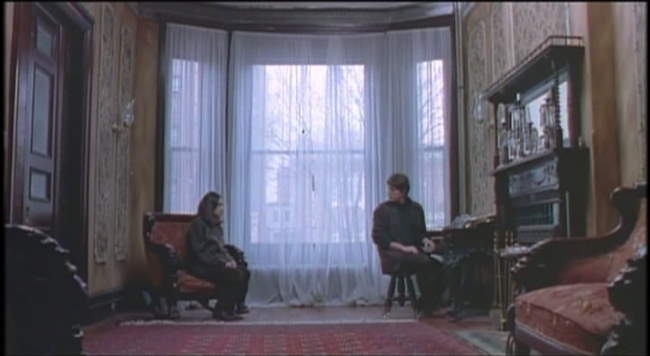
The majority of the movie takes place in a Victorian style townhouse, completely devoid of modern technology. Other sets include a decrepit, failing local grocery story, and a run-down apartment. Most external settings are comprised of run-down industrial areas. While the movie itself takes place in the future, aside for a few technology shots, the audience has to rely on the narrative and suspension of disbelief for this to work.
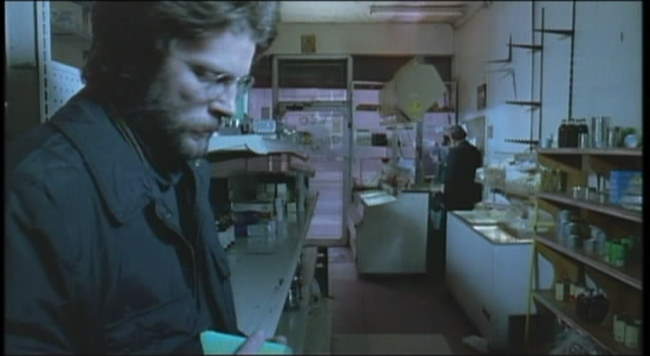
The Story: Humanity, it seems, is a shadow of its former self – random violence amongst is the norm, and virtually everyone we see in Puzzlehead is emotionally fractured. What little remains of the beleaguered populace is either making their way by becoming completely self-sufficient or by leaching off of others. It is in this setting that we focus on Walter – an emotionally fractured scientist who has trouble even walking out his front door. Unfortunately for Walter, he is in love with the very reclusive, local grocery store attendant, Julia (wonderfully played by Robbie Shapiro), but has never gained the courage to even attempt talking with her.
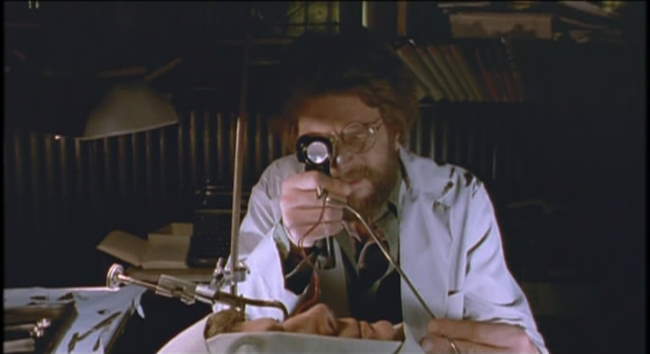
Walter (played by Stephen Galaida) decides to create an android named Puzzlehead (also played by Stephen Galaida) completely in his own image, apparently to serve as his external persona to interact in a world he prefers to avoid, and also to hopefully prompt interaction with Julia. After creating Puzzlehead, Walter spends significant time instructing Puzzlehead how to act. Walter is very derogatory controlling in his training of Puzzlehead. While Walter creates Puzzlehead with sentience, he severely restricts Puzzlehead’s behaviors. Over time, it becomes apparent to Puzzlehead that Walter has created and is using Puzzlehead for his own selfish purposes. In effect, Puzzlehead realizes that Walter sees him as nothing more than property. After Walter allows Puzzlehead to start venturing forth into society, he eventually comes into contact with Julia. Things get interesting when Walter follows up on Puzzlehead’s initial encounter with Julia.
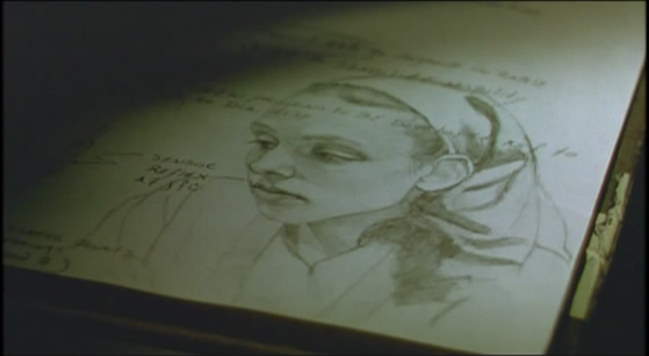
Puzzlehead Works Better on Second Viewing: Puzzlehead is told in narration format by the android, Puzzlehead, long after these events have taken place. In total, this approach works pretty well. Although, it does have the added side-effect of making the movie work better upon second viewing. There are a number of apparently throw-away comments that the narrator (Puzzlehead) gives that the audience simply can’t process until they’ve seen the story. However, upon second viewing, this adds a context to the movie that is missing the first time through.
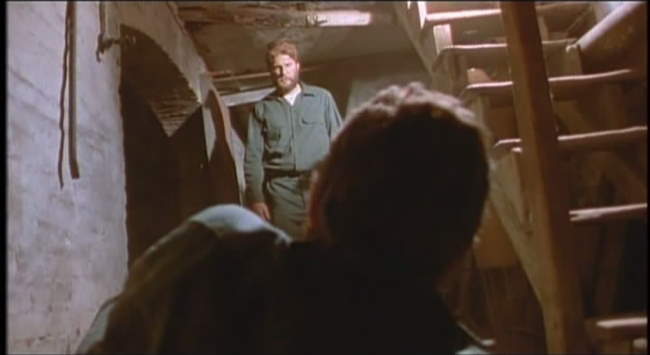
The Cinematography: Because the pacing in Puzzlehead is very slow, it runs the risk of inducing audience boredom. Luckily, this is largely overcome by the continually excellent shot selections throughout. It’s clear that significant thought went in to camera angles and interesting lighting approaches. Continually, we are treated to shots with extreme close-up foreground elements with action and movement occurring in the background. This approach, along with many low angle shots contributes to the sense of alienation the narrative provides.
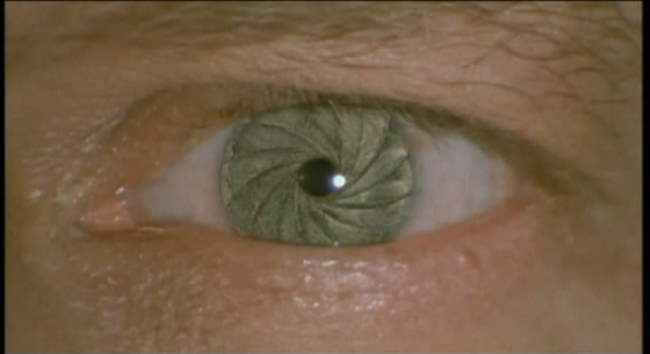
How does an Android Develop “true” Freewill? Puzzlehead provides us with a very interesting take on the development of android sentience and self-awareness. Puzzlehead is created using a neuron-scan from his creator’s brain (Walter), and thus, has all of his memories (yet, most are rendered meaningless without the context) – unfortunately, this scan has also left Puzzlehead riddled with Walter’s flaws. Puzzlehead’s biomechanical brain, like a human’s brain, is structured and controlled by belief structures and associative memories. Emotions, which are already troubling and confusing for Puzzlehead, develop into uncontrollable deviant behaviors.
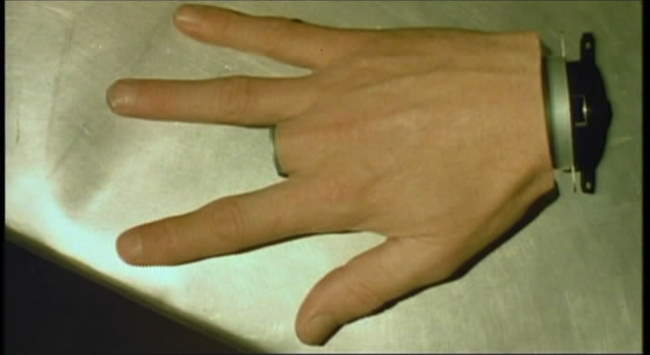
As Puzzlehead begins to develop self-awareness and freewill, he notices these tendencies that control him. These behaviors impact Puzzlehead’s ability to act the way the “real” him wants to act. His android brain, a combination of (undefined) biomechanical parts, is similar to a human’s in that he can recognize when he is doing deviant behavior, but cannot change his actions. But unlike humans, because Puzzlehead is an android, he can consider options for reprogramming his initial operating conditions. One question Puzzlehead ultimately poses is this – do androids have the possibility of becoming “exactly” the type of sentient being they want to become?
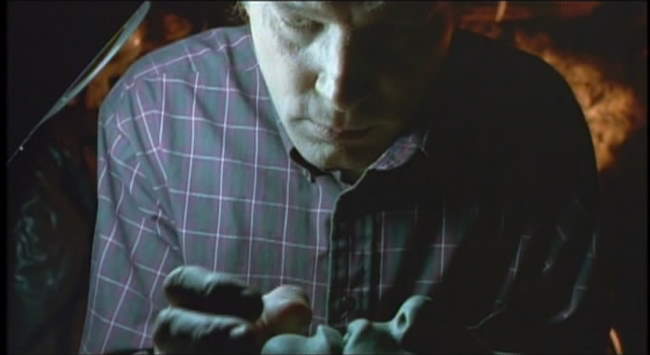
This potential ability to be “perfect” in the sense of transforming into exactly what Puzzlehead wants to become serves to reinforce Asimov’s notion that sentient robots would consider themselves superior to humans. In Puzzlehead, we get a realistic glimpse of how this might look.

Puzzlehead is an Intensely Personal Film: In judging this movie strictly on what I could learn from watching it I give it 7 stars (I would give it 7.5 if I had half stars – something I’m still working on). As a bonus, in talking with the film maker, it turns out that the film itself is an intensely personal metaphor of James Bai’s – one that you would never guess but makes perfect sense once you are told of it. Watching it with this knowledge, the complexity of the movie itself ramps up significantly, as does its accomplishment as a film – so much so that I’m strongly inclined to add another star to the review. I won’t give this part away, but instead offer Mr. Bai the opportunity to comment here if he would like to describe Puzzlehead’s personal nature in his own words.
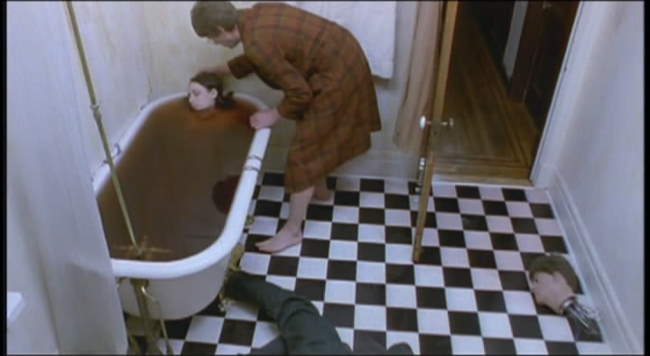
The Bottom Line: James Bai has created a very low-budget flick that’s definitely worth a watch. While I had some problems with the acting in some of the early scenes (Galaida as Puzzlehead acts way too human at the beginning, but eventually settles into the role), and a few of the visuals which seemed too 70s looking, these are diminished as the movie progresses. Bai poses some interesting thoughts on android development – some of which are unique to movies. If you can stand a very slow-paced, intellectual cyberpunk flick without a lot of cyberpunk visuals (although I LOVE the bathroom and broken arm scenes), Puzzlehead is definitely worth a watch.
~See movies similar to this one~
Movie Review By: SFAM
Year: 2002
Directed by: Gary Fleder
Written by: Philip K. Dick (story), Scott Rosenberg (Adaptation), Caroline Case et a. (screenplay)
IMDB Reference
Degree of Cyberpunk Visuals: Medium
Correlation to Cyberpunk Themes: Medium
Key Cast Members:
Spencer Olham: Gary Sinise
Hathaway: Vincent D’Onofrio
Maya Olham: Madeleine Stowe
Cale: Mekhi Phifer
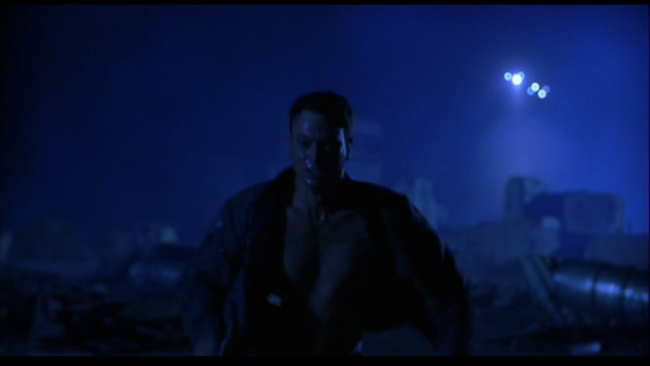
Overview: Impostor got bashed by critics for having bizarre cut always, too many slow motion scenes, and generally weird and herky-jerky cinematography decisions. Additionally, others criticize it due to originally being a 30-40 minute short that got extended into a full-length movie. While all true, I truly like both the story (basically the Fugitive, done in a near future setting) and the acting, especially by Gary Sinise and Madeleine Stowe. While the cinematography is definitely subpar in this Philip K. Dick story, the movie itself is still worth a watch.
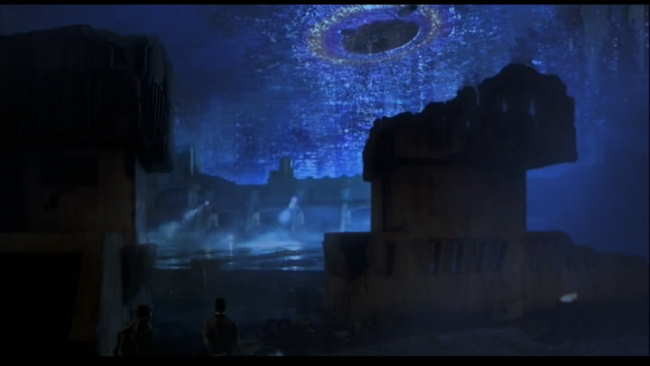
The Story: Impostor is set in the year 2079, a time when a race of aliens are attempting to invade the earth. To protect the population, humans now live in high-tech “bubbles” which seem to be able to keep out Alien weapon systems. Because of this, the aliens have resorted to creating DNA-based replicants, not unlike those in Battlestar Gallactica, by a process which apparently involves copying captured humans. These replicants are in actuality very powerful bombs, but have no self-awareness of being replicants – when their “trigger” is invoked (such as being in close proximity to their target), they explode.
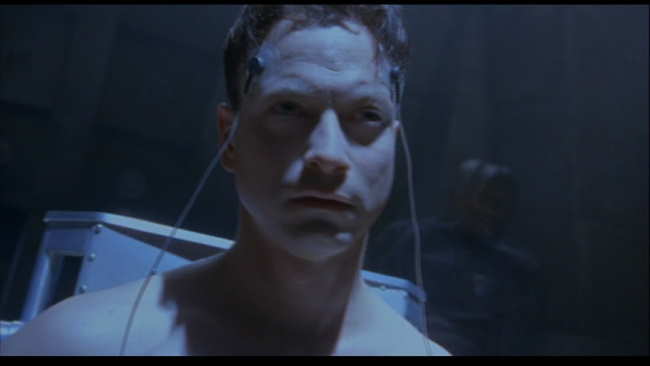
Sinise plays Spencer Olham, a weapons scientist who has been accused of being replaced by a replicant (called a cyborg in the movie). The security head (Vincent D’Onofrio) captures him and threatens to rip out his heart in order to prove that he’s not a human. Sinise escapes and then engages on a journey to prove his innocence. Olham determines that he can prove his innocence by equipment at the hospital where his wife (Madeleine Stowe) works, that compares a previous body scan with his current body. Unfortunately, he’s already gotten out of the city, and now needs to figure out how to get past security to return.
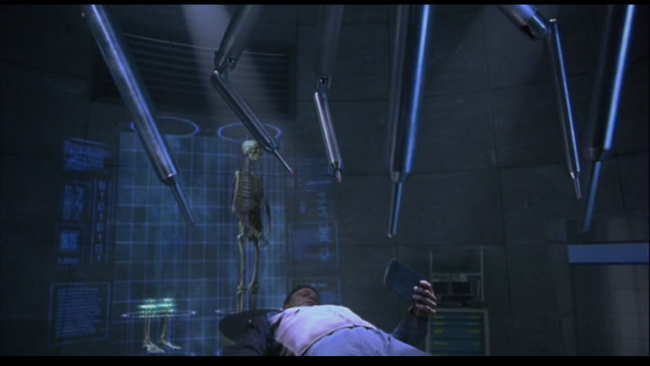
How Do You Know You’re You? This, in essence is the question Impostor is asking when it’s not in chase-filler mode. Is Spencer Olham a human caught in a horrid mistake, or is he a cyborg comprised of human-like bio-matter that is in actuality a powerful bomb sent by aliens to infiltrate Earth’s defenses in order to kill human leadership? If you were a cyborg-replicant imbued with the memories of the original host, how could you figure it out? Imposter briefly mentions the notion that the cyborgs don’t have a soul, but this is never pursued. One wishes they had come up with some way of quantifying a soul. But in the end, we are left to answer this question ourselves.
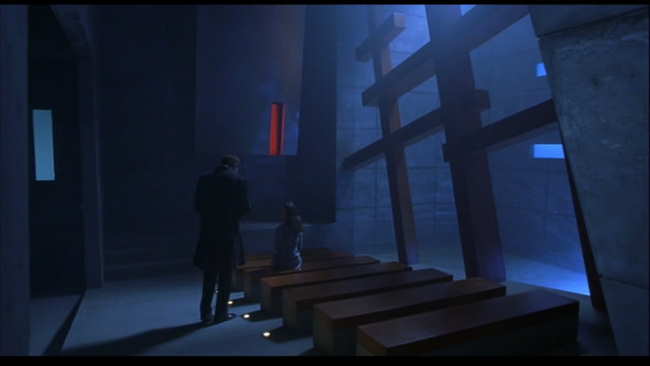
The Middle “Chase” scenes are Filler: Originally, Impostor was shot as a 30-40 minute movie short that was intended to be part of a larger collection. Apparently, Miramax liked the short enough (or cooled to the short collection idea) that they wanted it extended into a full length feature film. However, in doing so, they were left with a relatively tight beginning and tight end, and then a vast chasm of nothingness in the middle. By and large, the middle is filled with semi-pointless chase scenes that are sprinkled with people that aren’t germane to the central plot. Now we get a whole underground dystopia thing added to the mix, whereby it turns out that the nice hospital is ONLY for those who live in the bubble, while those in the outer area get little or no medicine and support. In its better moments, the middle part of the movie seems to want to emulate a “Fugitive” type feeling, but this doesn’t always work well. The DVD also includes the original movie short which is definitely worth a watch.
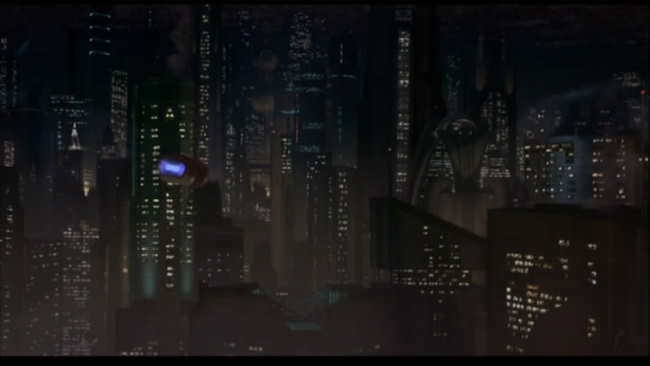
The Visuals: Impostor’s vision of the future is terrific in some places and haphazard in others. The cityscape scenes look right out of blade runner, the bubble city coverings, torture look great, but the majority of Imposter involves treks through regular looking tunnels. The torture equipment and medial imagine equipment are both more than passable. Imposter is strongly dominated by blue tones, which pervade most every aspect, from the chase scenes to the interrogation scenes.
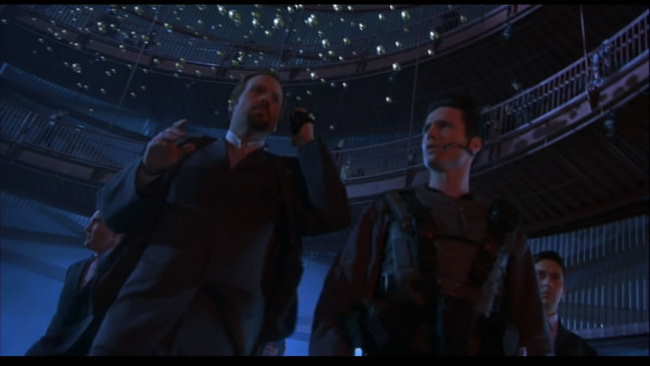
The Acting: By far, the best aspect of Impostor is the acting.Gary Sinise in particular really sells his role well, but Madeleine Stowe and Vincent D’Onofrio also give high quality performances, and Mekhi Phifer is at least passable. With slightly worse performances, Imposter could have easily ended up in the cheesy “B” Movie bin. The effects are uneven enough (some looked great, others looked TV-ish) that solid acting was a must to keep this movie watchable.
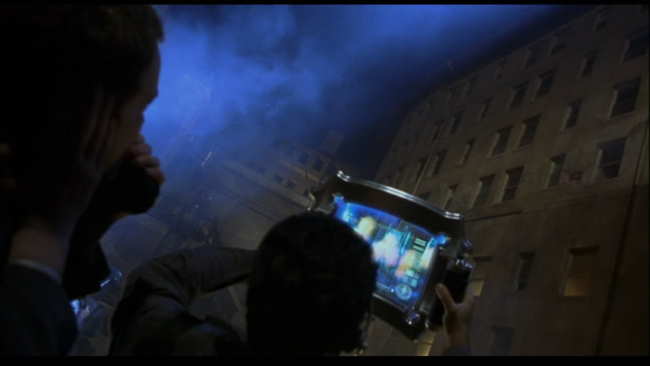
The Editing: Impostor is rightly criticized for crazy and continuous cut-shots. Rare is the shot that lasts more than 4 to 5 seconds before cutting to another view. The goal was to add to the tension of the chase scene, but the editors went overboard. Especially when combined with some strange shot angles, Imposter almost takes on an experimental vibe, as if they weren’t sure what would work, so they tried various different things.
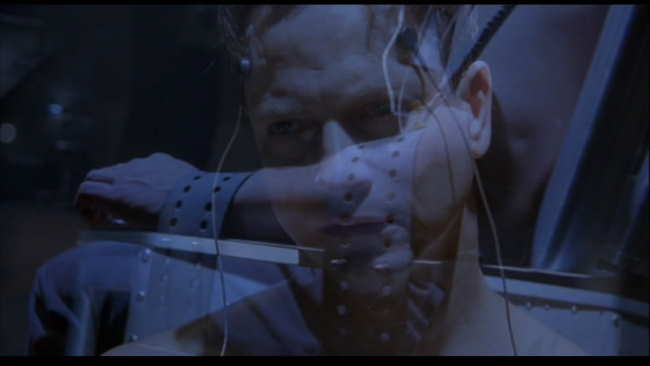
The Bottom Line: While this “Fugitive-like” movie has lots of interesting scenes, it’s the ending that I really like - definitely a cool twist. The acting is solid and the visuals are sometimes, but not always, pretty decent. There are lots of pointless tunnel-running that easily could have been cut by 15-20 minutes, and also, there are enough questions and plot holes that stop Imposter from being a great movie. Still, the question of determining humanity is an interesting one, and is well executed.
~See movies similar to this one~
Movie Review By: SFAM
Year: 1991
Directed by: Shozin Fukui
Written by: Shozin Fukui
IMDB Reference
Degree of Cyberpunk Visuals: High
Correlation to Cyberpunk Themes: Medium
Key Cast Members:
Pinocchio 964: Hage Suzuki
Himiko: Onn Chan
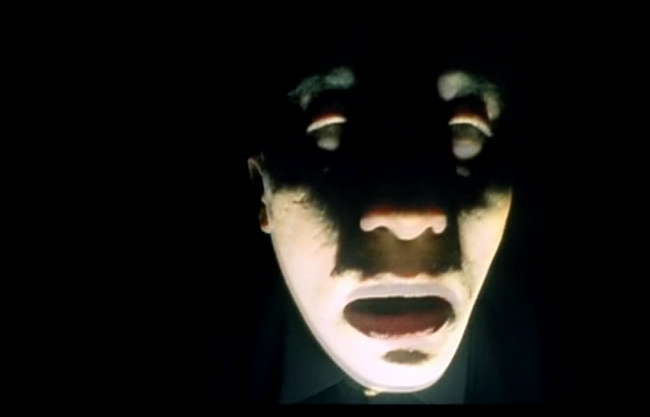
Overview: Back in 1991, Shozin Fukui and crew created a no-budget movie that provided yet another view of Japanese Cyberpunk, one very different from the first Japanese Cyberpunk movie, Tetsuo. In 964 Pinocchio, we don’t get an external merging of man and machine parts – instead, we see the residue of extreme internal struggles – ones that overwhelm the protagonists. The images are very intense, and the pacing is erratic and fast paced. While this movie is uneven and haphazard in places, 964 Pinocchio is definitely a unique experience.

The Story: In this film, 964 Pinocchio (Hage Suzuki) is a strange type of cyborg – someone that used to be human but now has been transformed into a sex slave sold as product. Unfortunately, he no longer “functions” so his owners, a pair of sex-crazed, truly bizarre and sadistic chicks, have thrown him out in the street. Simultaneously, a nurse with a mysterious past, named Himiko (played by Onn Chan), has lost her memory, and she too has been evicted to the streets.

The two outcasts meet up and seem to have a strange attraction to one another. As 964 Pinocchio is essentially a child who seems to have little understanding or awareness of the external world, Himiko takes care of him. She takes him to her living quarters in the basement of a deserted building, and takes him on a food shopping spree where they steal and eat food in the grocery store. Himiko finds out that the corporation that produced Pinocchio is feverishly looking for him, as they are afraid that their illegal process for creating sex slaves will be made public.
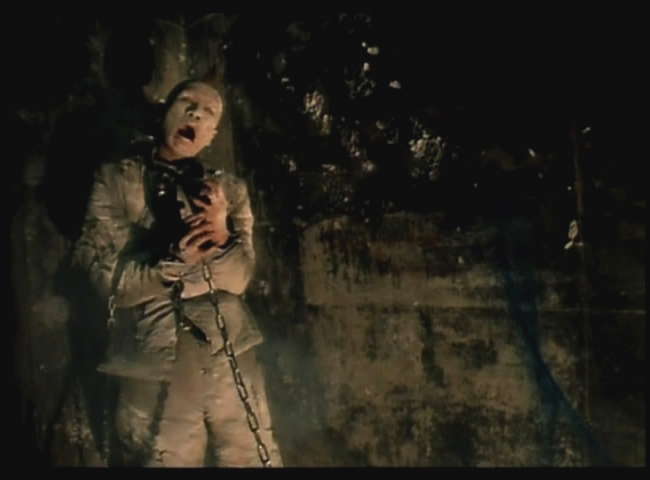
Eventually, 964 Pinocchio starts to gain awareness, and begins to wonder what has happened to him. After becoming frightened and agitated, Himiko calms him down, and then they both realize they have found a “like” soul and then make love (apparently 964 Pinocchio is able to perform when his feelings are re-engaged). Unfortunately, this event unleashes unseen forces inside of 964 Pinocchio – forces that are past the point of control. In short, all hell breaks lose – 964 Pinocchio begins spouting bodily fluids of all kinds and Himiko is thrown against the wall, and finally begins experiencing her own version of the horror. From there, the movie becomes a experiential voyage into the crazed and surreal. The corporation is still after 964 Pinocchio, but they soon discover he is not the same as he once was.
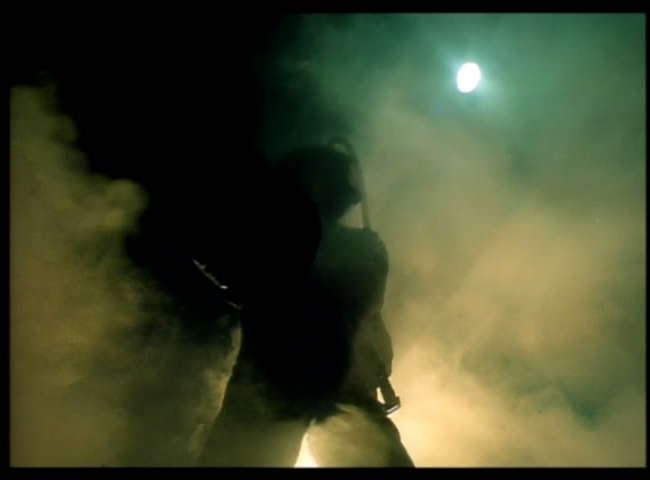
Rubber’s Lover is the Prequel to 964 Pinocchio: Even though it was created 5 years later, Fukia’s Rubber’s Lover is a sequel of sorts to 964 Pinocchio. In this film, we never really understand the process for how Pinocchio was created. Rubber’s Lover gives us a view of this. While the cover for the DVD describes 964 Pinocchio as an android, he’s really not. In fact, he’s virtually all human (although there is a drill to the forehead scene that shows brain matter being removed). If Rubber’s Lover is any guide, he was created by intense sound waves and special chemicals. So at one point he “was” human, but now is “post-human.”
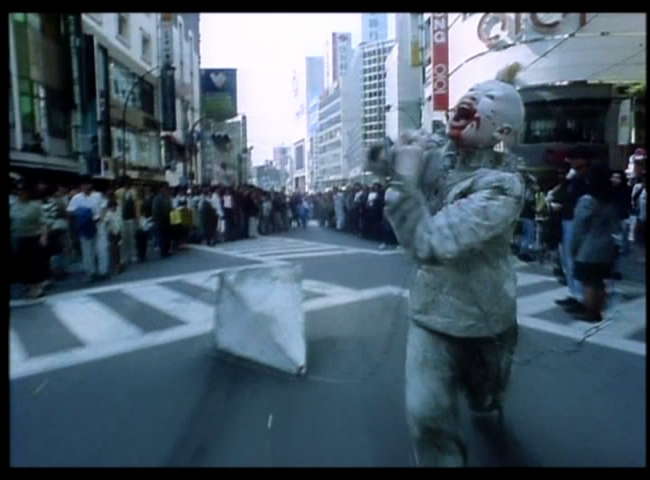
Note to Low Budget Japanese Cyberpunk Film Makers – Use B&W: Because of the low to no budget nature of 964 Pinocchio, the FX are not top quality. While they probably worked better prior to the CG world that we have today, similar to Videodrome, they look very dated in places now. This takes away from the impact of the movie to the point that it just doesn’t really work now unless you put it on a big screen and really crank up the sound. In comparing Tsukamoto’s Tetsuo (a B&W movie) to Tetsuo II: Bodyhammer (a color movie) and Fukui’s Rubber’s Lover (a B&W movie) to 964 Pinocchio, it’s clear that the mood, visuals and ambiance required for Japanese Cyberpunk is FAR better provided by B&W over color. In addition to both Tetsuo and Rubber’s Lover being better movies, they are both FAR more immersive. The low-budget B&W effects don’t detract from the mood, whereas in comparison the color effects look very fake. As an added benefit, shooting in B&W gives the film maker the a critical tool for cyberpunk mood setting: shadows. The use of shadows in a B&W film serve to create a dark, noir feeling which automatically serves up a non-normal mood.
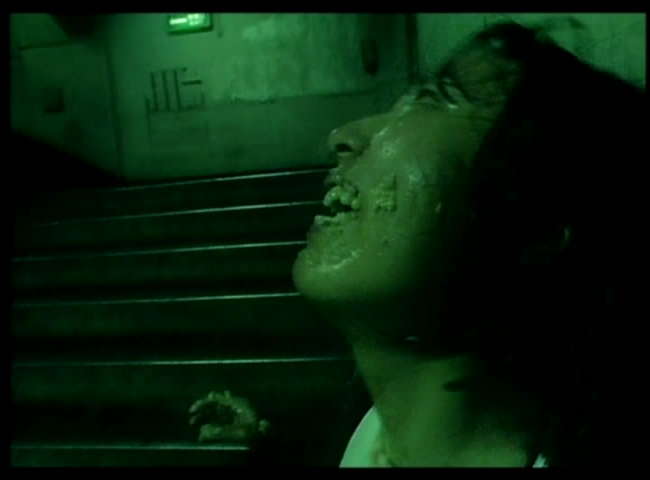
If You Have Vomit Fetish, 964 Pinocchio is For You! Fukui CLEARLY has a vomit fetish, and decides to share it with us in 964 Pinocchio. We’re not talking a wee bit’O vomit coming out - we’re talkin GALLONS worth! Himiko in particular vomits, wipes it on herself, wallows in it, and then eats it all back up! Yummy!
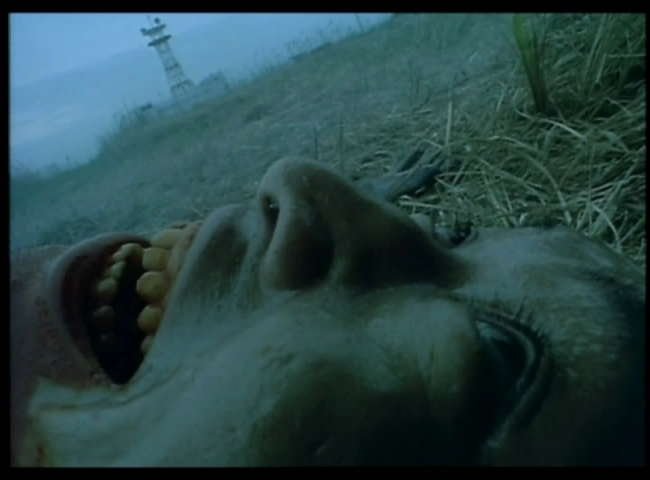
The Bottom Line: 964 Pinocchio is not polished fare, but it does etch out a place in the history of cyberpunk. The story is rather basic, and is really beside the point (many are left confused at the ending – page 2 gives a spoiler understanding if interested). The purpose is to create an immersive mood that details what happens when a dominant power emerges and exceeds human physical capacities. 964 Pinocchio is not for everyone – in fact it’s for a select few. If you aren’t a fan of extreme horror, gruesome imagery, constant screaming, jagged camera work and intense emotions, this movie is probably not for you. If you just want to see a Fukui film, you’re probably better off picking Rubber’s Lover. But if you want an instance of Japanese Cyberpunk in color – the first one in fact – 964 Pinocchio merits a watch.
Page 2: More Intense Screencaps and Spoiler Understanding of the Ending–>
~See movies similar to this one~
Movie Review By: SFAM
Year: 1982
Directed by: Aaron Lipstadt
Written by: Don Keith Opper, James & Will Reigle
IMDB Reference
Degree of Cyberpunk Visuals: Low
Correlation to Cyberpunk Themes: Medium
Key Cast Members:
Max 404: Don Keith Opper
Dr. Daniel: Klaus Kinski
Maggie: Brie Howard
Cassandra: Kendra Kirchner
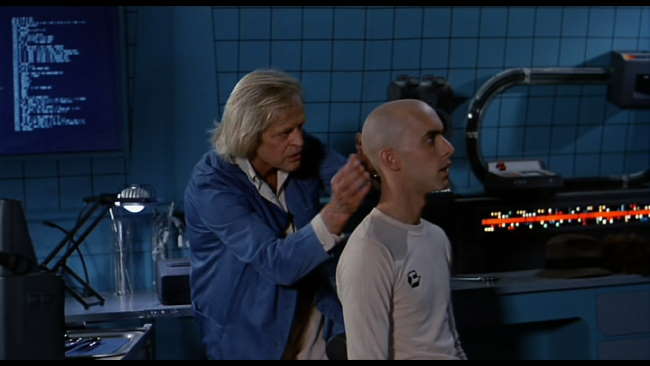
Overview: There are some really good Sci-Fi movies that I don’t consider strictly cyberpunk, but still are strong enough in some ways that I feel compelled to include here. Android is one of those films. Android, in a very low-budget manner, gives us a wonderful exploration of androids and their early attempts to assimilate with humankind. On top of this, the writing is interesting and the acting is very good, especially Klaus Kinski and Don Keith Opper. The budget is low enough that the FX and set designs actually do detract some from the enjoyment of the film, but not enough to stop you from seeing this.
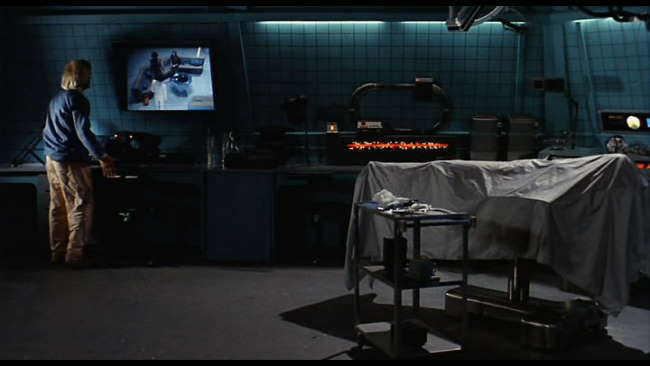
The Story: Android takes place on a large but deserted research-oriented space station located in deep space. Dr. Daniel (played wonderfully by Klaus Kinski), a genius by unstable scientist has almost completed his greatest creation – a perfect female android, named Cassandra. Apparently, Androids have been outlawed on Earth, due to some catastrophic event that occurred previously (hence, the reason for the deep space station), so Dr. Daniel must continue his work under cover with only minimal assistance. His current assistant, Max 404 (Don Keith Opper – also the writer) is also an android, but he is but a prototype – an imperfect experiment may no longer be necessary to continue. Unfortunately, Dr. Daniel needs a living female to “give Cassandra life” by transferring some of her essence to Cassandra.
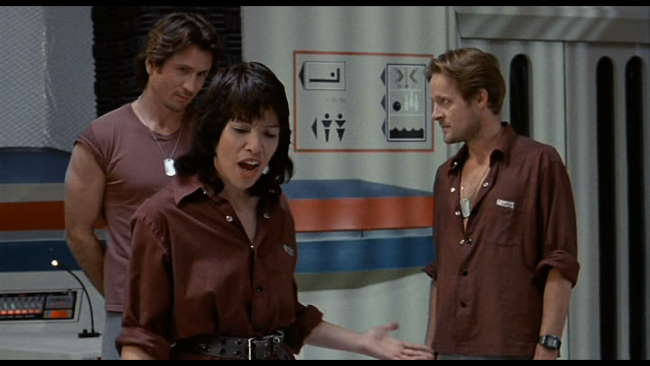
Providence strikes when an outlaw group of criminals on a run-away space ship ends up in their quadrant with a ship in need of repair. As they dock, the criminals, two men and a woman, happily greet Dr. Daniel and Max, and begin looking for what’s valuable to steal, while Dr. Daniels sees this as his golden opportunity to get a woman to finalize his android. Max 404 is immediately attracted to Maggie (Brie Howard), the female convict. At the prompting of the other convicts, Maggie humors Max 404 in order to find out more information. Things come to a head when Max 404 overhears Dr. Daniel say that Max will be deactivated when Cassandra comes online. Max decides his only chance for life is to leave with the convicts, and decides to take things into his own hands.
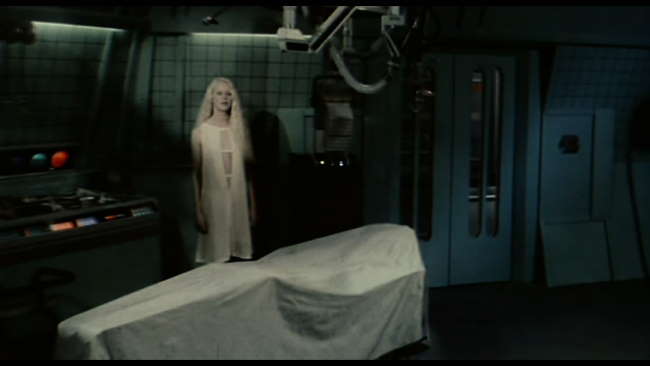
Metropolis’ Maria Recreated: Android employs some fun linkages between previous movies. Max 404 tends to enjoy old B&W, and tends to watch ones that foreshadow coming plot scenes. One of the cool scenes in this movie was when Max 404 is watching the movie Metropolis on the computer monitor. The scene where the evil scientist, C.A. Rotwang is creating an evil android version of Maria from the human Maria. In Android, Dr. Daniel needs to capture Maggie to use her essence to “give life” to the perfect android, Cassandra. The parallels are obvious, and are appreciated to anyone familiar with Metropolis. In another scene, Max 404 is watching “It’s a Wonderful Life” where Stewart finally gets up the urge to go see Mary at her house – this occurs right before Max 404 has his love scene with Maggie.
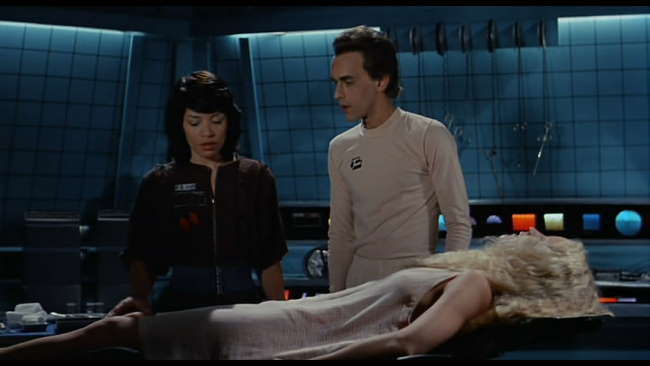
Android Coming of Age Story: One of the really interesting things about Android is Max 404, only 5 years old, engaging in a coming of age type story. Max has the ability to think and feel, but has never experienced anything outside the boundaries of the space station. He spends his time dreaming of Earth, playing video games, and imaging himself engaging in interesting life experiences. He’s not human, but unfortunately for Max, this is the only model he has in determining how to act and react to new situations. Maggie provides him his first opportunity to “engage” in a way that he’s always wished. As soon has things come to a head, Max’s choices are markedly different than a human might be. Max doesn’t feel guilt, nor does he worry about human taboos such as murder, etc. But the highlight of the movie is Don Keith Opper’s acting when he thinks Dr. Daniel (Kinski) is going to deactivate him – this alone is almost worth watching the movie for.
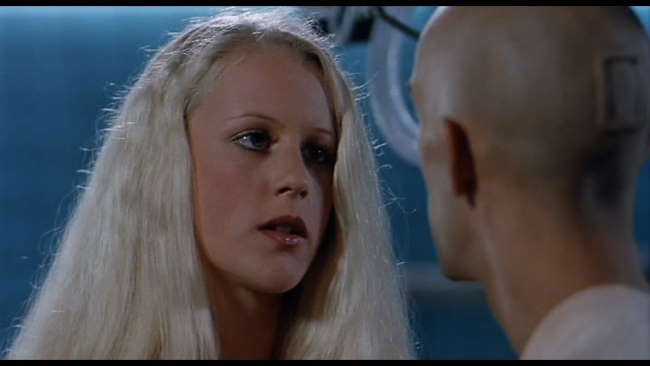
Notice the control panel on the back of Max 404’s head.
The FX: The FX in Android is extremely low-budget. In listening to the commentary, we find out that the story was written as a way to gain additional monetary benefit out of an existing space station set. Android never veers into Dr. Who FX territory, but there are a number of cheesy looking elements that do detract somewhat from the mood. The ships that come to dock have a decidedly Saturday morning kids show look, and the guest suites look very 70s with the off-color strips going around the wall. Still, for the most part things generally work.

The Bottom Line: Android is one of the really well made low-budget Sci-Fi movies of the 80s. The FX aren’t great, (except for one cool scene that’s a spoiler – DON’T CLICK on this unless you’ve seen the movie - spoiler “decent FX” shot), but the story more than makes up for it. Android gives us a pretty interesting view of a young, imperfect android, engaging in the “coming of age” story, and dealing with challenges far different than perhaps a human might. The ending is also interesting, when Cassandra finally awakes – she too acts differently than expected. In short, Android is a very well written, well acted, and interesting low-budget Android flick.
~See movies similar to this one~
Year: 2002
Directed by: Vincenzo Natali
Written by: Brian King
IMDB Reference
Degree of Cyberpunk Visuals: Medium
Correlation to Cyberpunk Themes: Medium
Key Cast Members:
Morgan Sullivan: Jeremy Northam
Rita Foster: Lucy Liu
Finster: Nigel Bennett
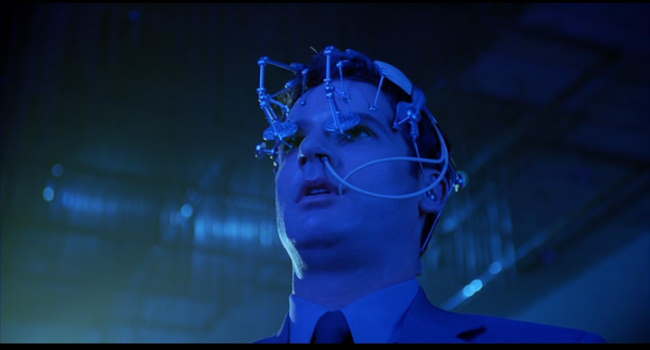
Overview: Canadian film maker Vincenzo Natali, master of doing more with less, delivers us an excellent cyberpunk flick for a virtual pittance budget. At 7.5 million, Cypher is FAR more polished than it has any right to be. This paranoid conspiracy, near-future espionage thriller provides a continual stream of mindfuck moments. Expect your head to get jerked around so much that you’ll need to check yourself for whiplash after watching it.
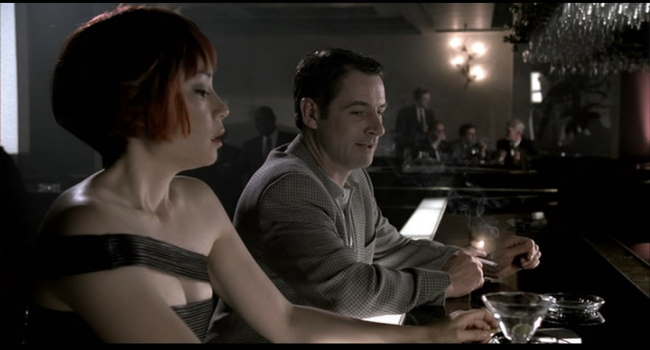
The Story: Jeremy Northam stars as Morgan Sullivan, a nerdy and slightly incompetent salesman who leads a bland life. His job is boring, his nagging wife is overbearing, and he spends most of his time yearning for some excitement to infiltrate his mundane life. In pursuit of this, Morgan applies for a job at Digicorp, a high-tech company, to become a corporate spy. But so far, the job is not the excitement he was looking for. The job involves assuming an fake identity, and then traveling to various non-envious US destinations and secretly recording boring conference speeches.
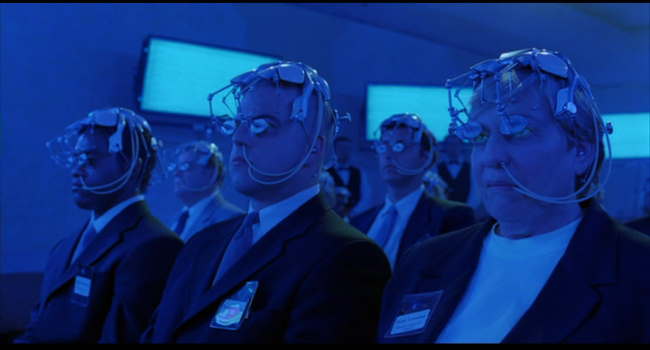
Morgan, now calling himself “Jack Thursby,” develops a persona associated with the name he’s given by Digicorp. He starts to imagine himself to be a suave and sophisticated player, who likes to smoke, drink scotch and pick up sexy women at hotel bars. During one trip he meets Rita Foster (Lucy Liu), who claims to work for a freelance expert named Sabastian Rook. She warns him that he is being brainwashed by Digicorp in order to infiltrate their rival company, Sunways Corporation.
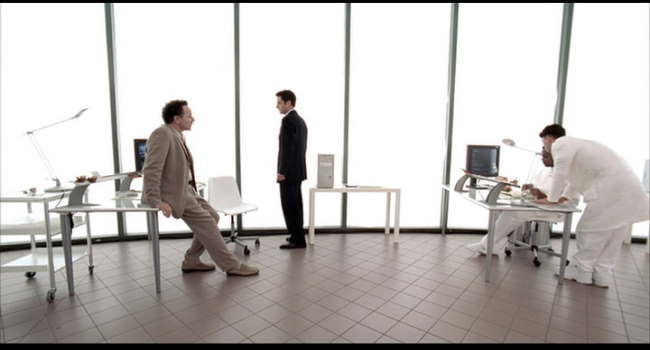
From there, the story becomes too complex to try explaining. The plot reveals layer upon layer of unraveling truth and reality. Morgan realizes he has become enmeshed in an ongoing high stakes corporate battle, and worse, events have so overtaken him that he has nowhere to turn and can trust nobody. Everyone wants to use him for their own purposes, as Morgan, while still a pawn in the larger scheme of things, has come into play.
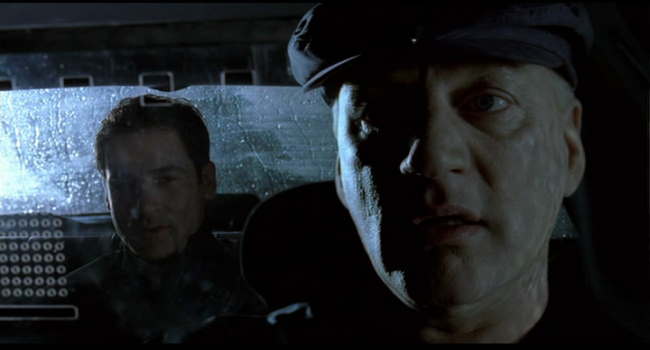
The Acting: Jeremy Northam, a British character actor, is simply brilliant at acting completely different personas over the course of the movie. He really nails a role requiring complex and diverse acting. Lucy Lui plays a terrific femme fatale who leads Morgan further down into the abyss. The rest of the cast also holds up well, including Nigel Bennett as Digicorp’s mysterious representative, and David Hewlett, who plays a completely bizarre character who lives in a data vault.
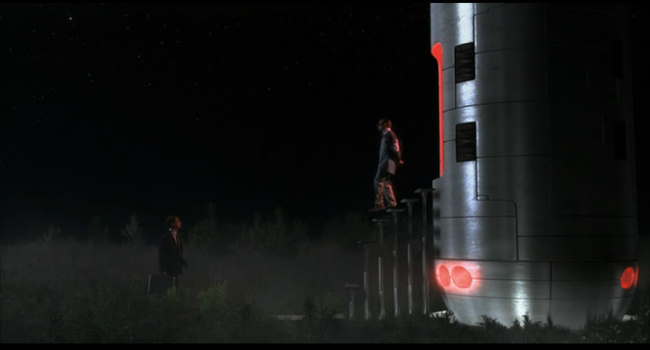
The FX: Truly, I’m blown away that Natali is able to pull over as many special effects as he has with a 7.5 million dollar production budget. The brainwashing headsets are clearly the highpoint of the movie, but many of the effects throughout are muted, but important. In looking at Cypher, most would conclude that this should have taken at least 25 million or so, and even then, they would have needed to watch costs. The range of sets, and completely different looks staggers the mind when the overall cost is presented. Make no mistake – I’m not comparing Cypher to big budget fares like the Matrix, but for the money, Cypher’s FX really look terrific. More importantly, they add important touches in bringing a near-future feel to an otherwise modern day setting.
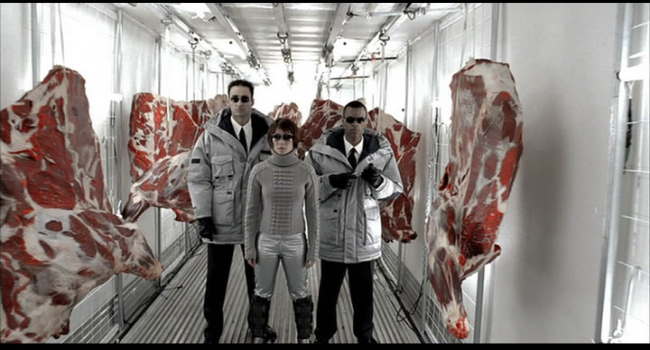
The Bottom Line: In many ways, Cypher comes across as a cyberpunk version of Hitchcock’s North by Northwest. The pacing and feel of Cypher is very similar, and in both movies, you really never know what’s coming around the next corner, but most assuredly it will involve more layers of out-of-control untruths. With all the goodness that Cypher gives us, you’d almost expect the final score to be a 9 or 10. But unfortunately, Cypher’s story falls apart at the end. The technical believability, which is decently high throughout the film, flat-out does a belly flop at the end, and expects us to buy something that anyone who knows a whit about data security, just can’t stomach (I can add a spoiler page on this if anyone is interested). However, this sore point is not enough to sap enjoyment out of an otherwise wonderfully made film. You may not have heard of Cypher, but this is not an indication of its quality. Give it a go – chances are you’ll love it!
~See movies similar to this one~
|




























































































